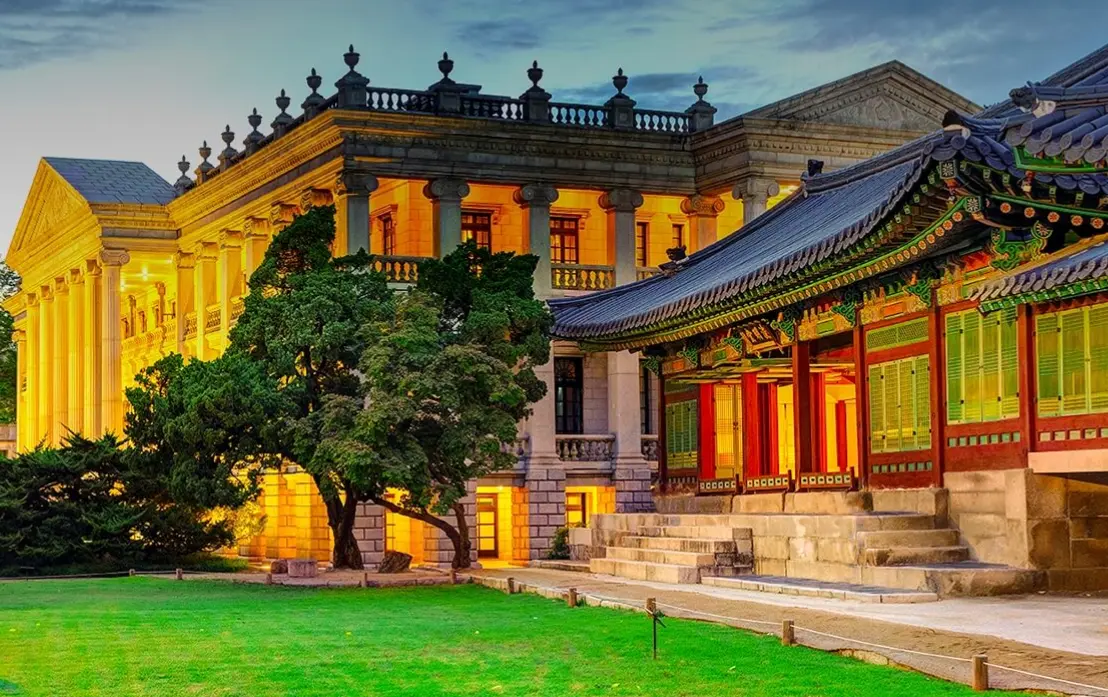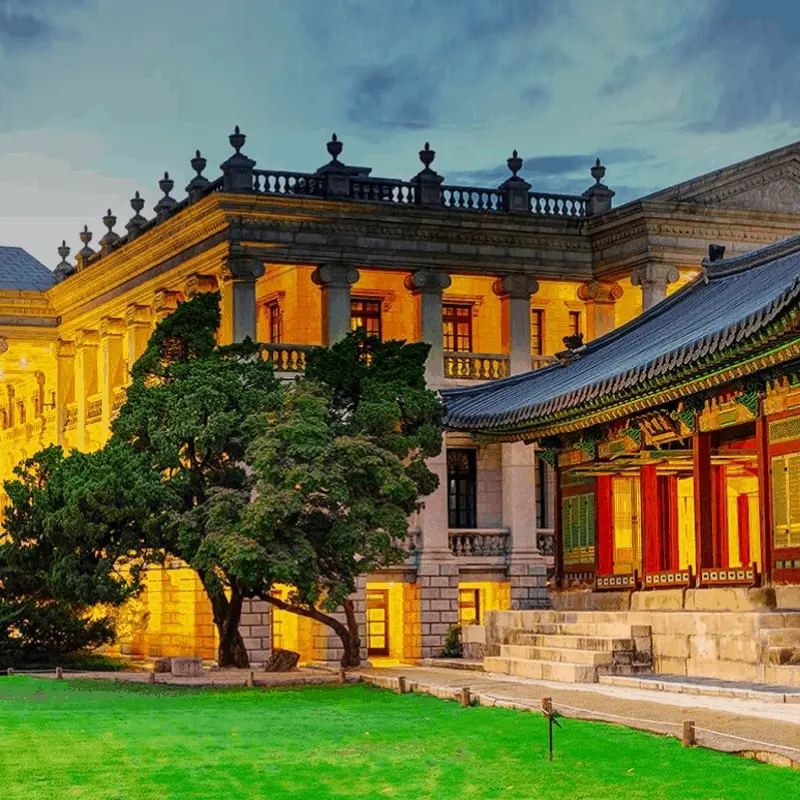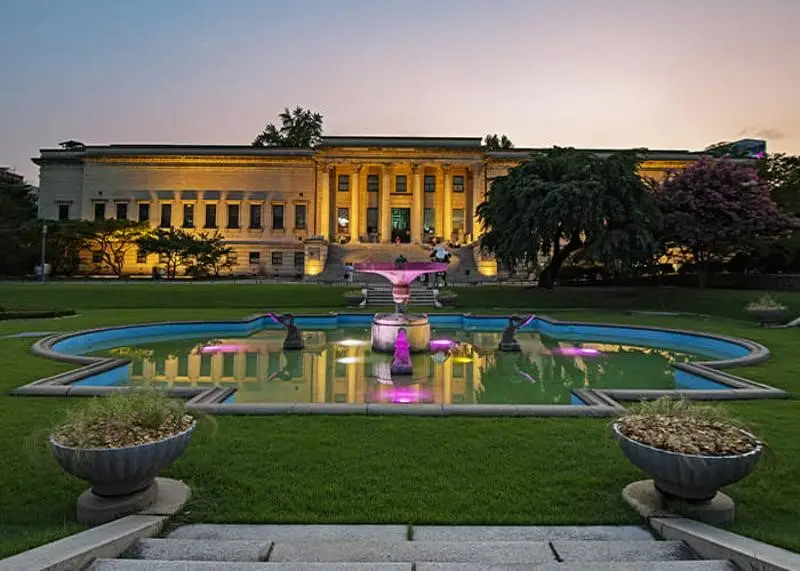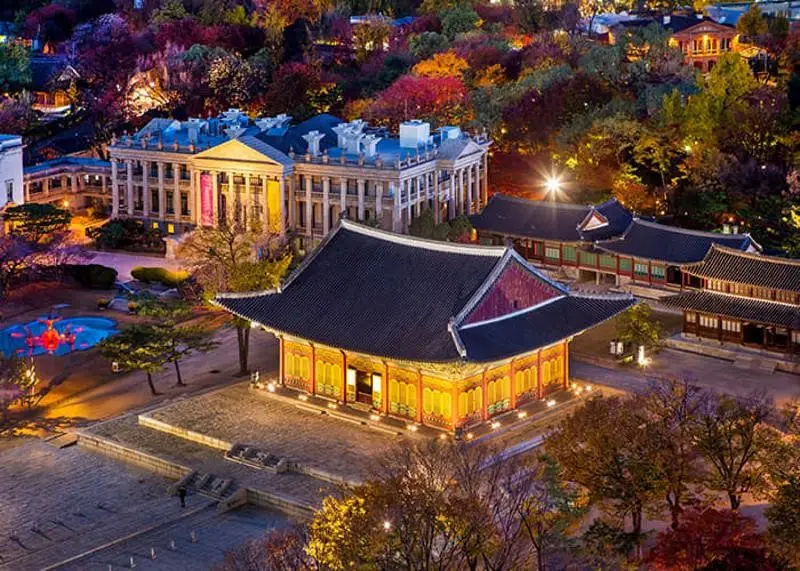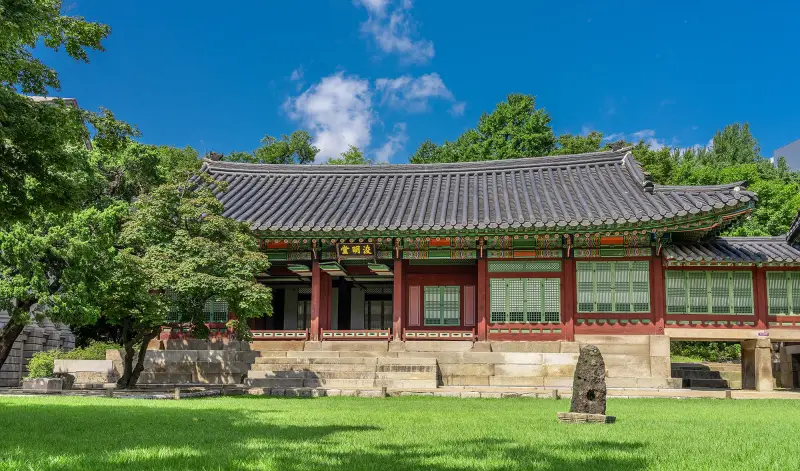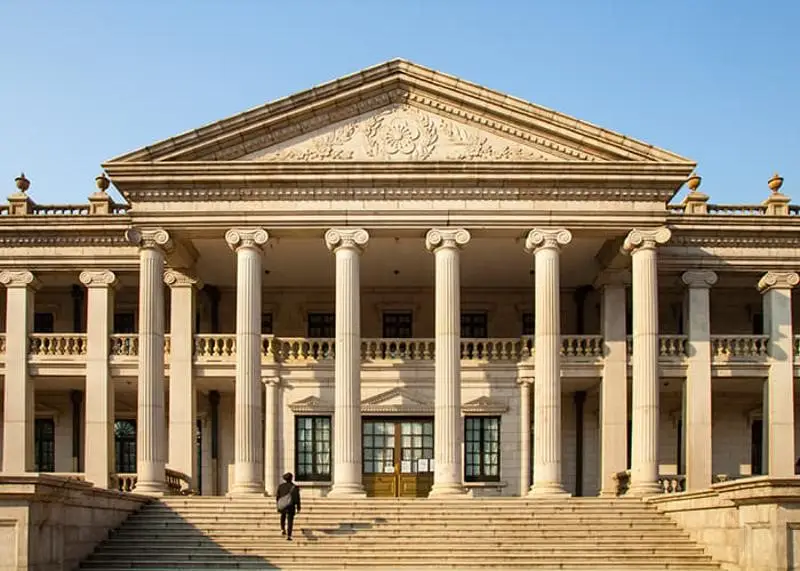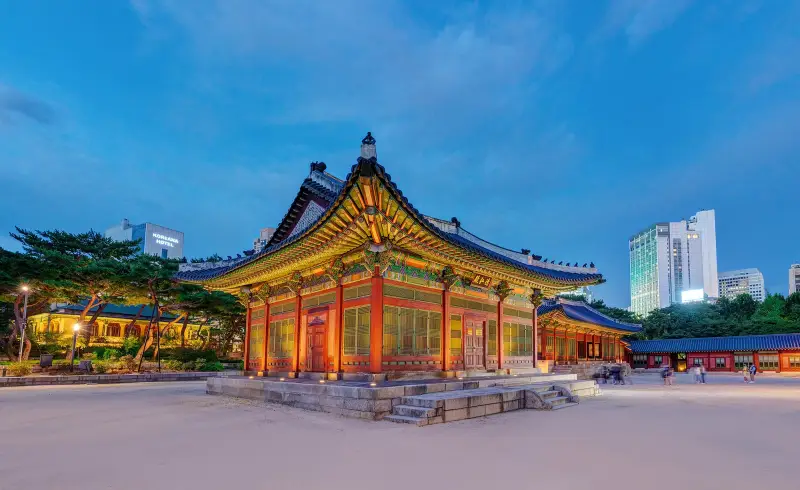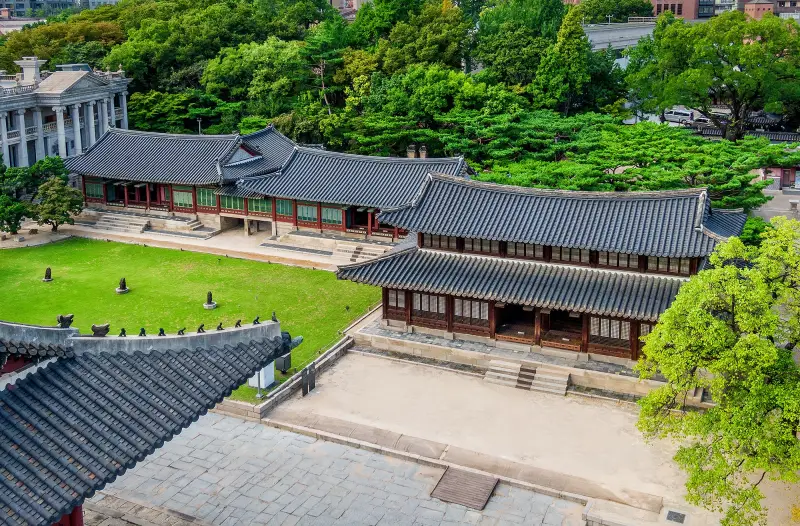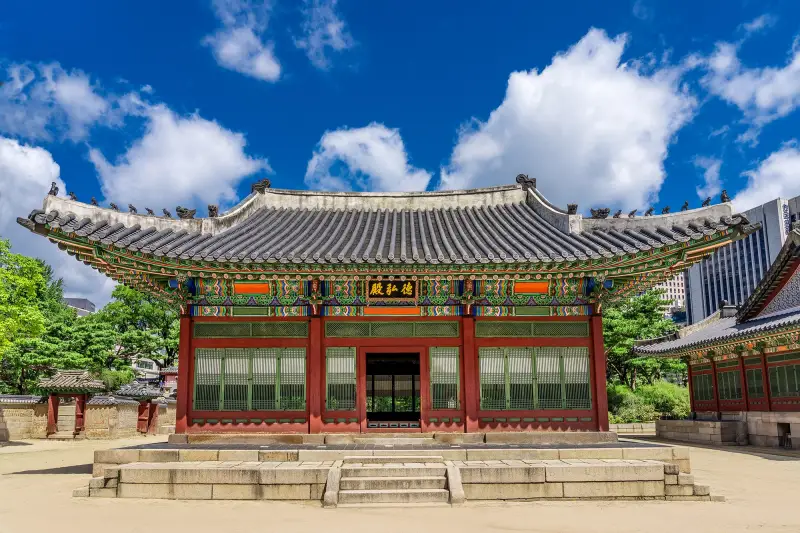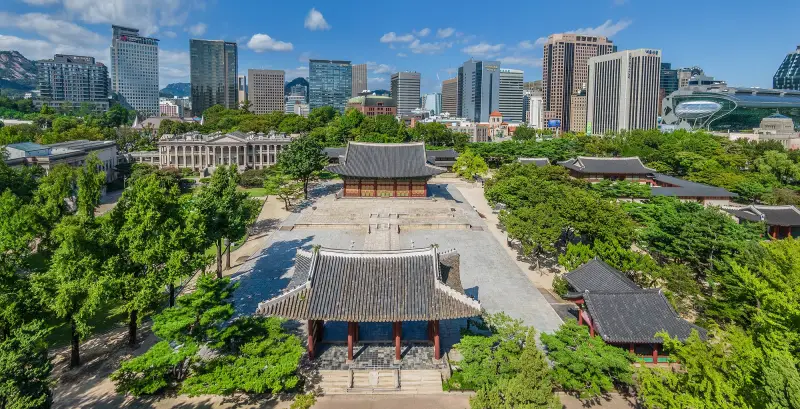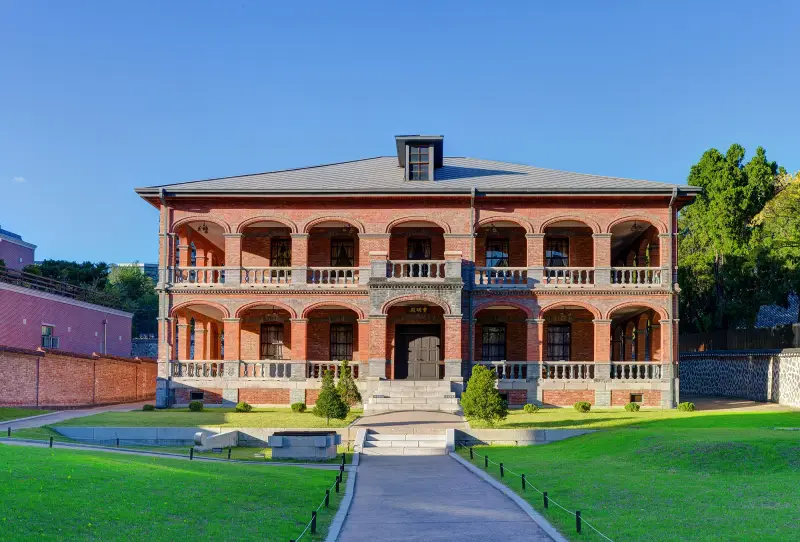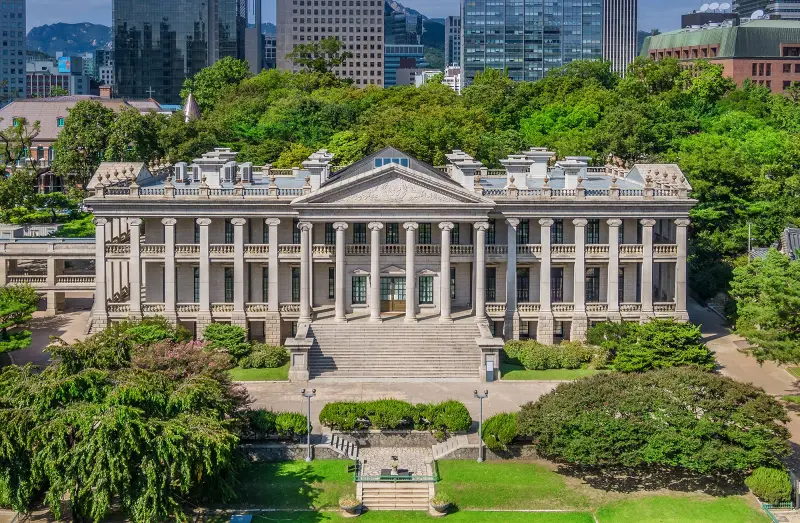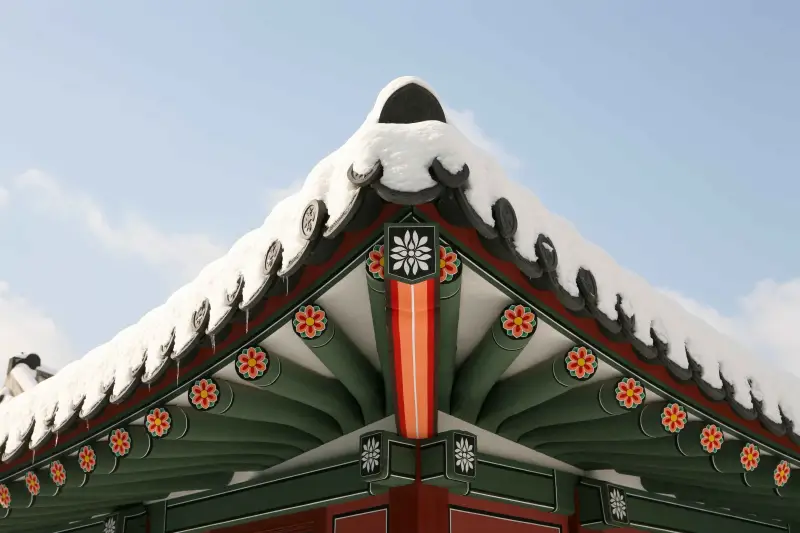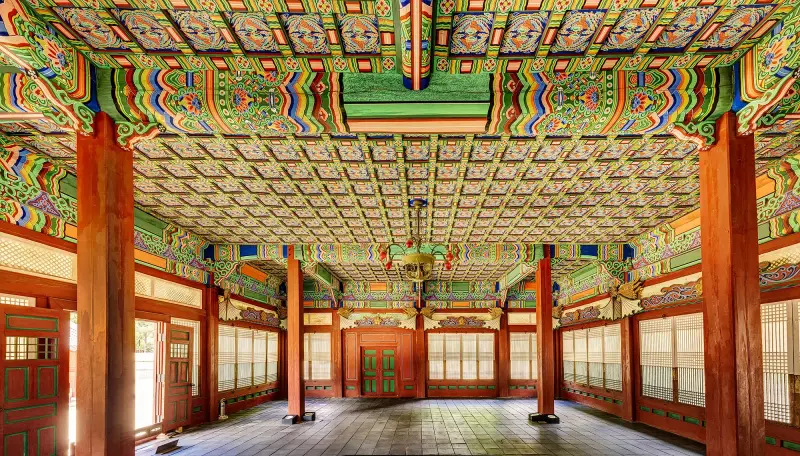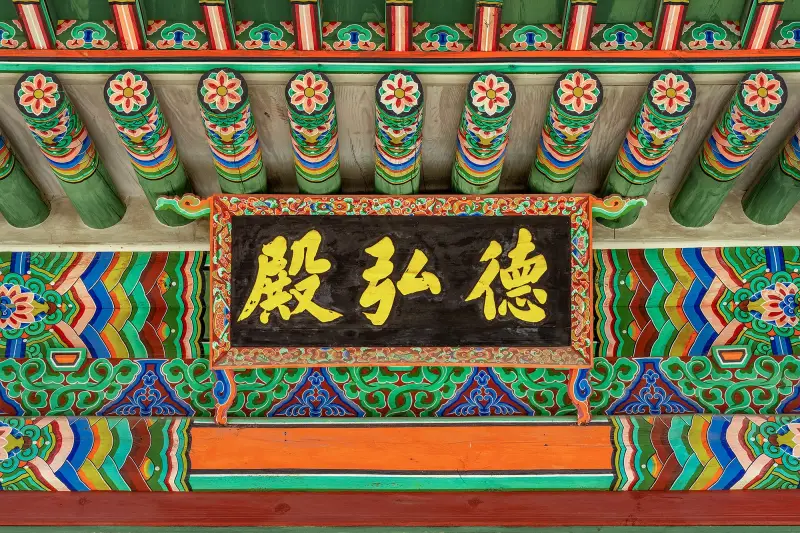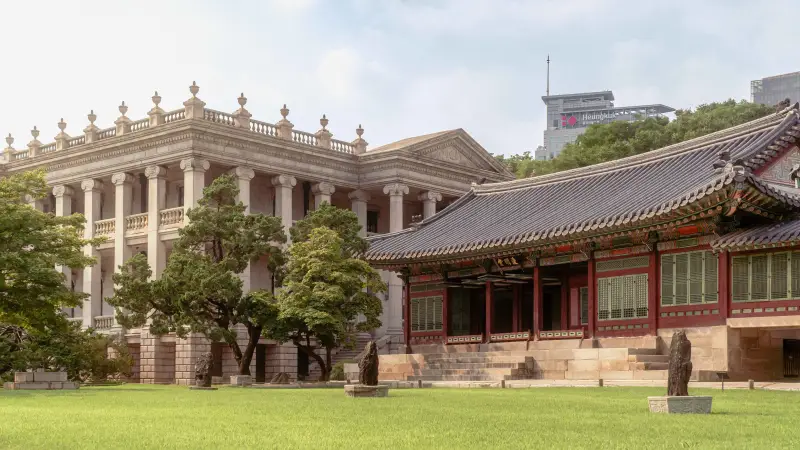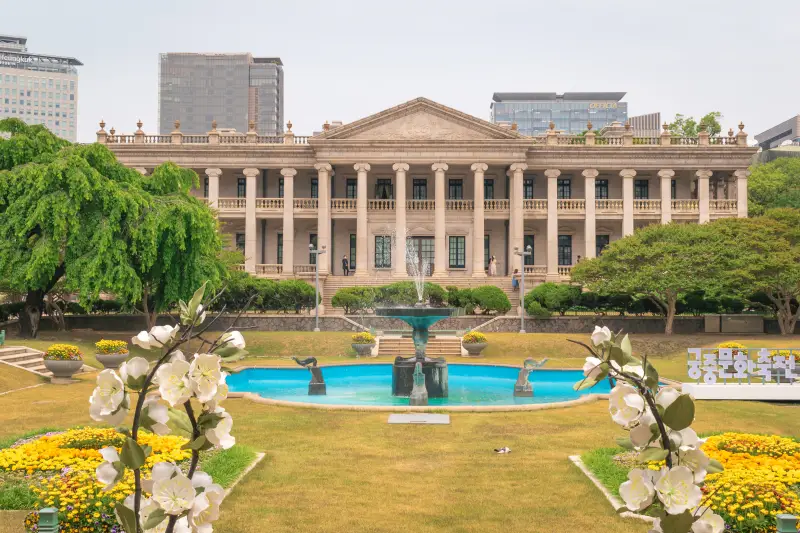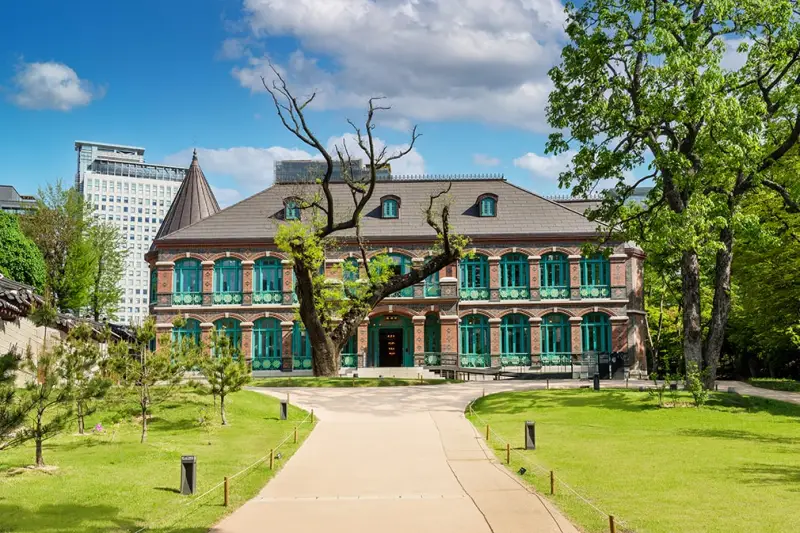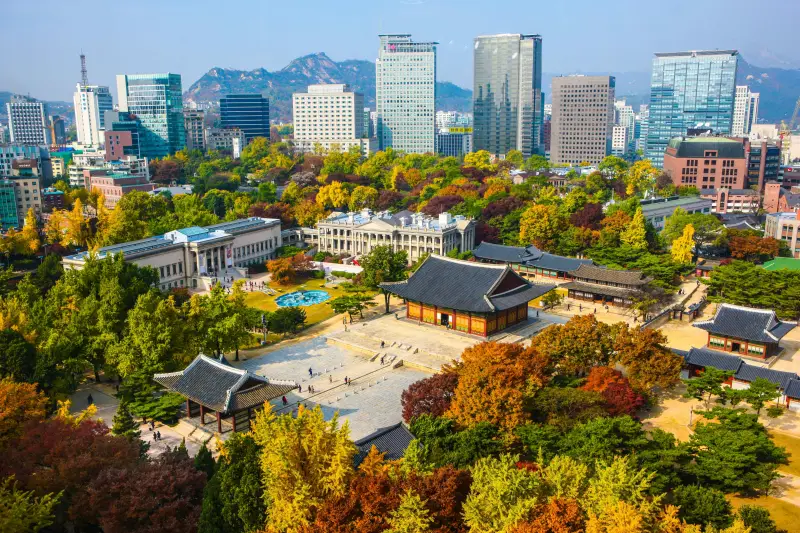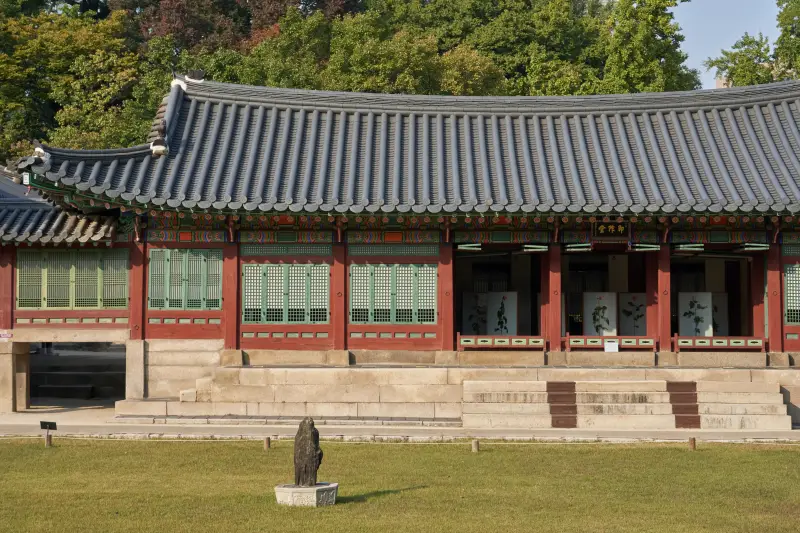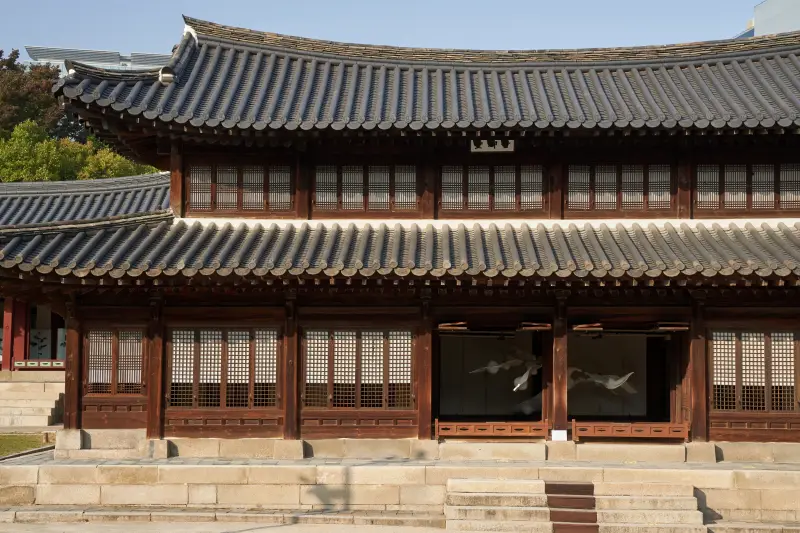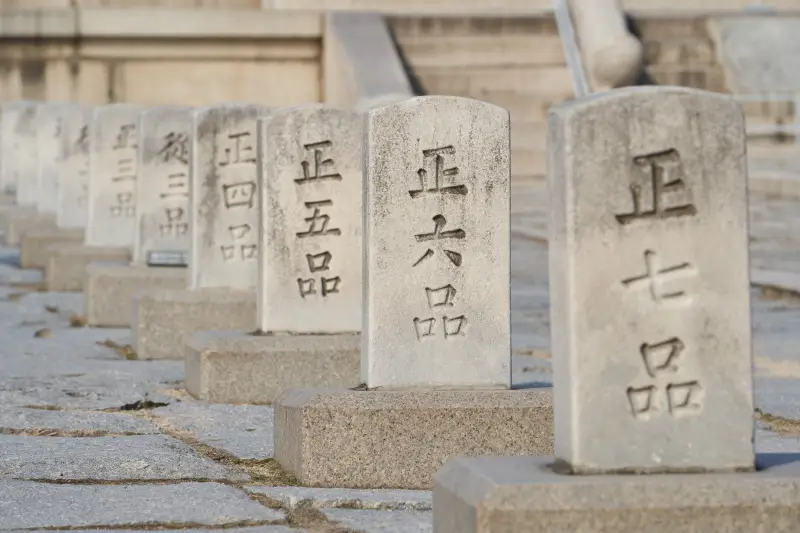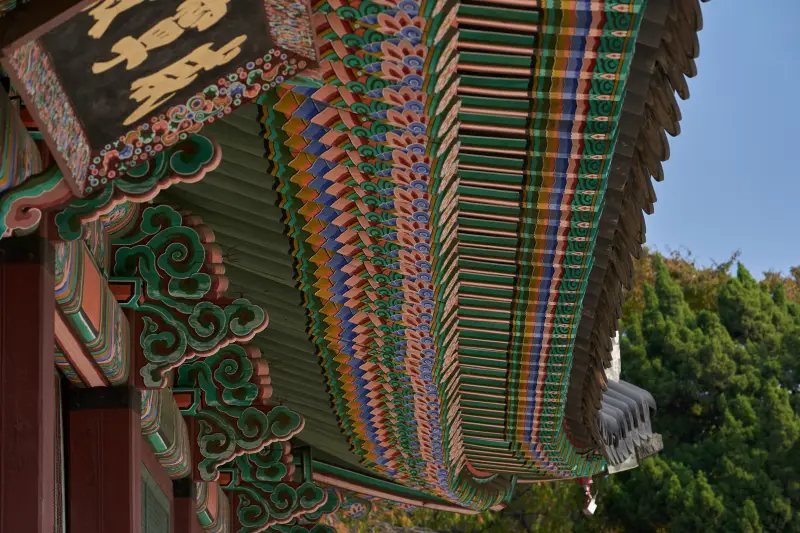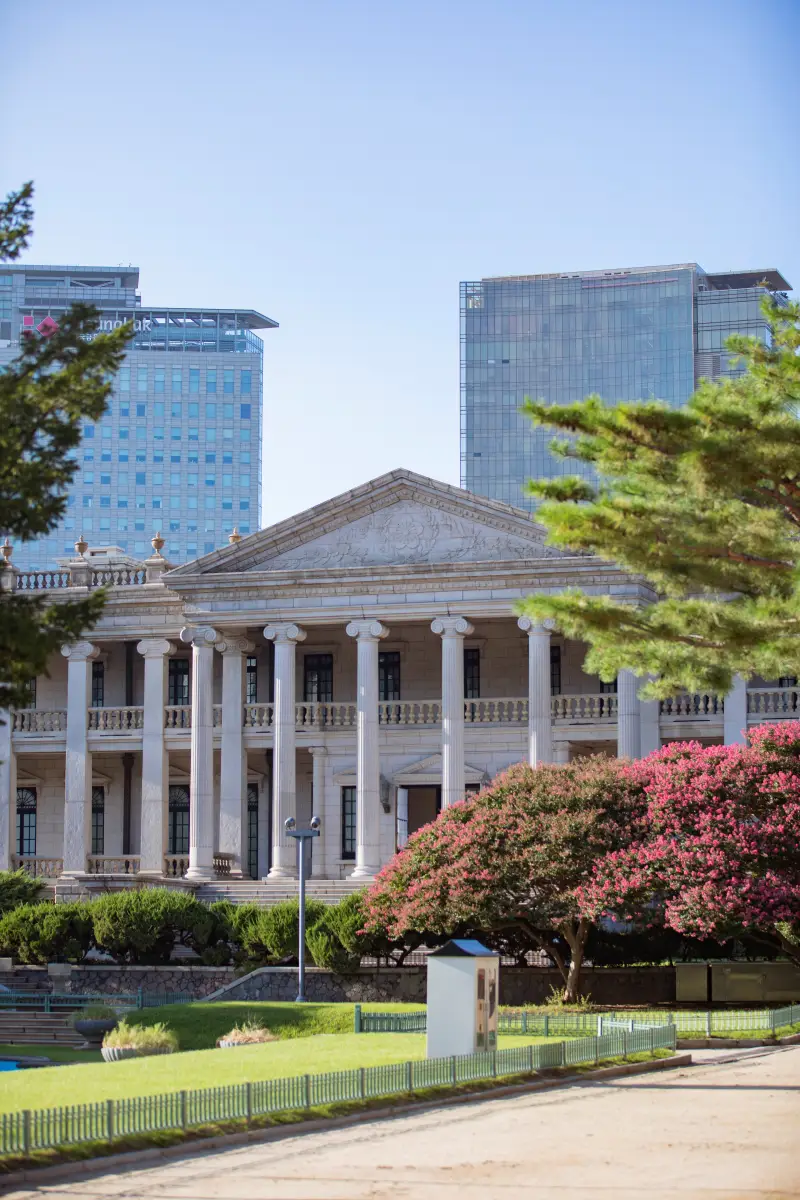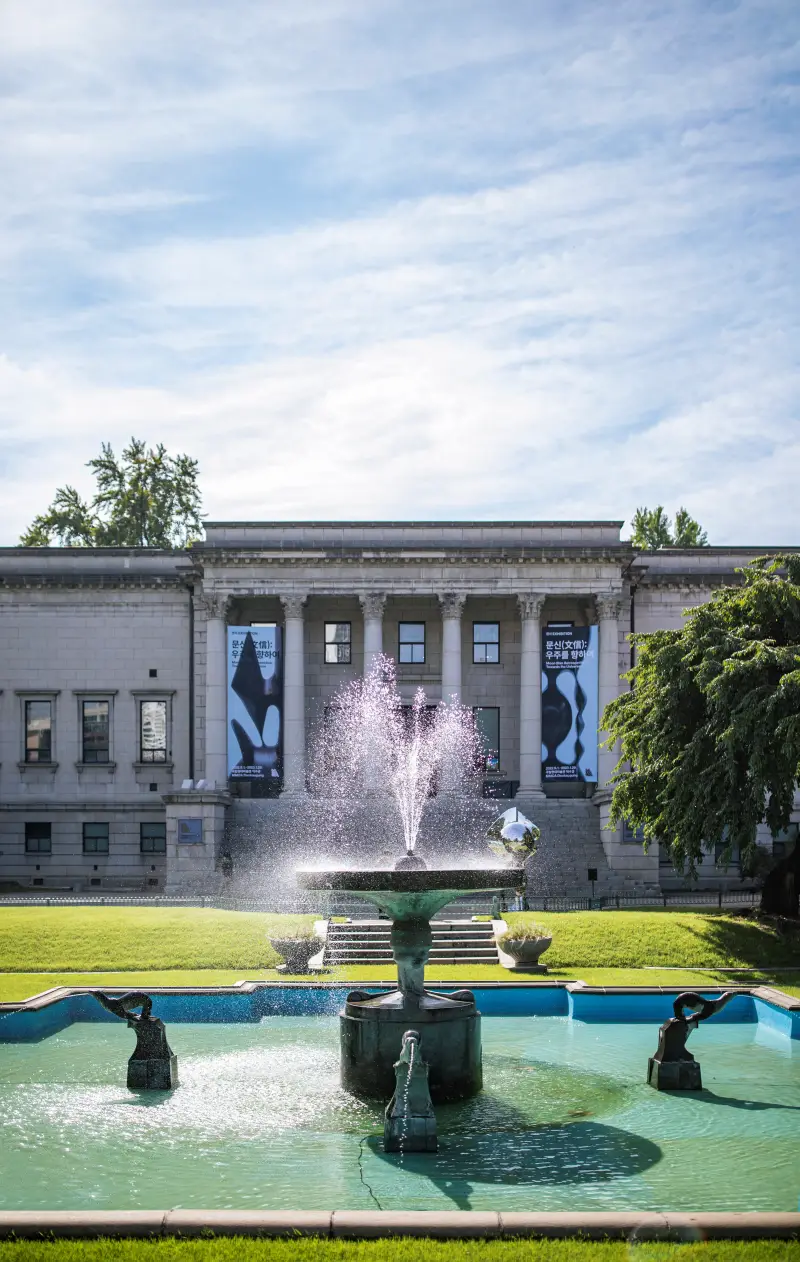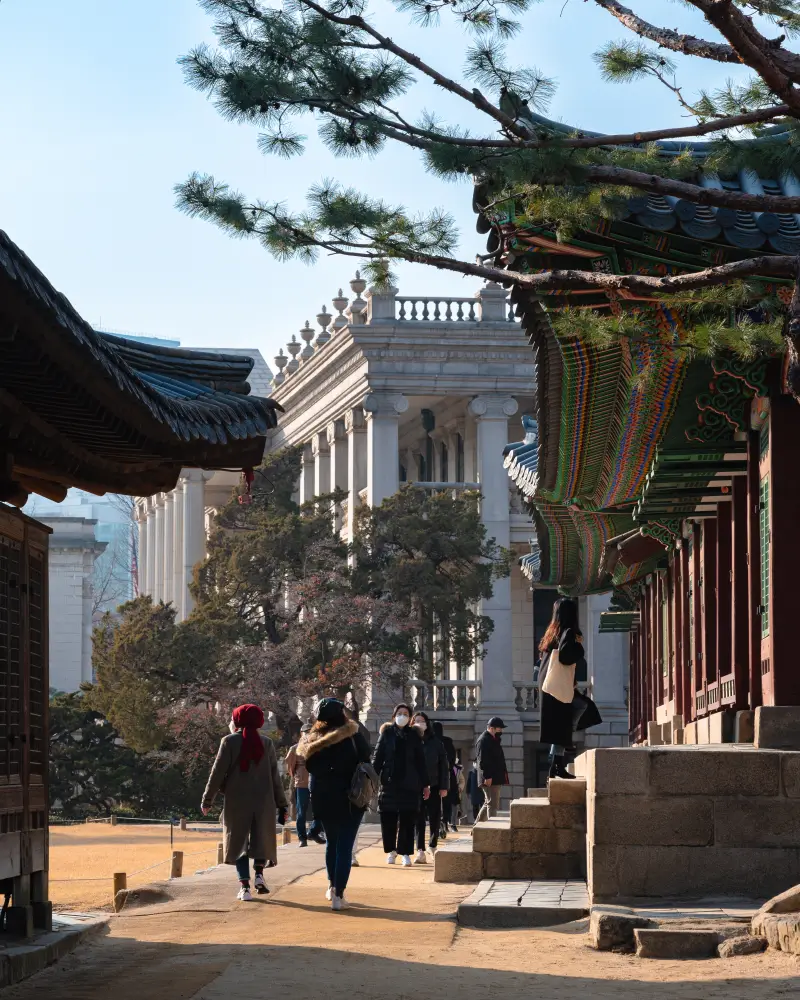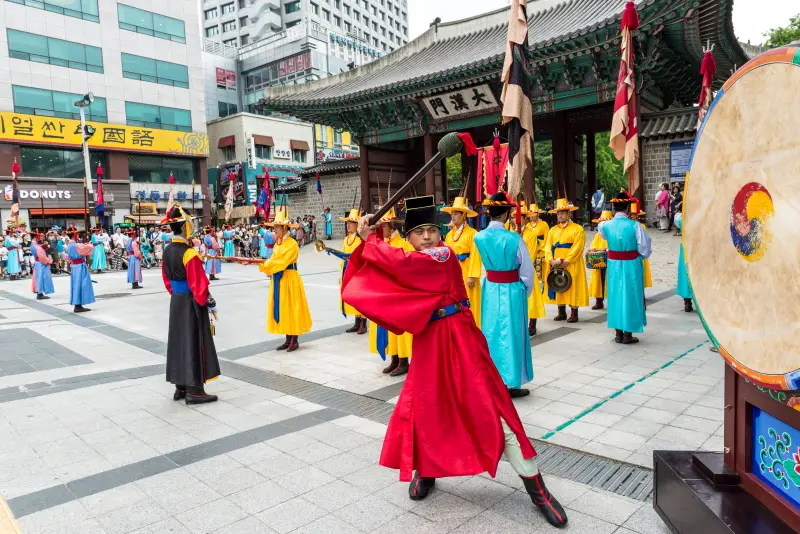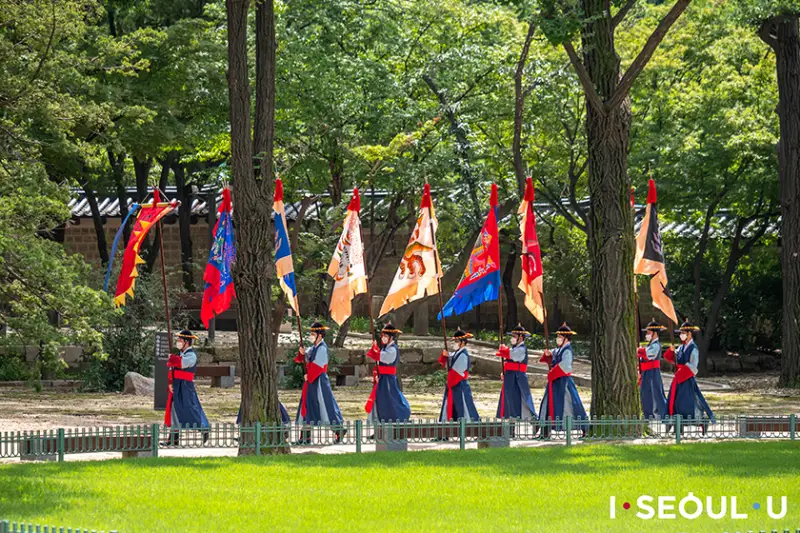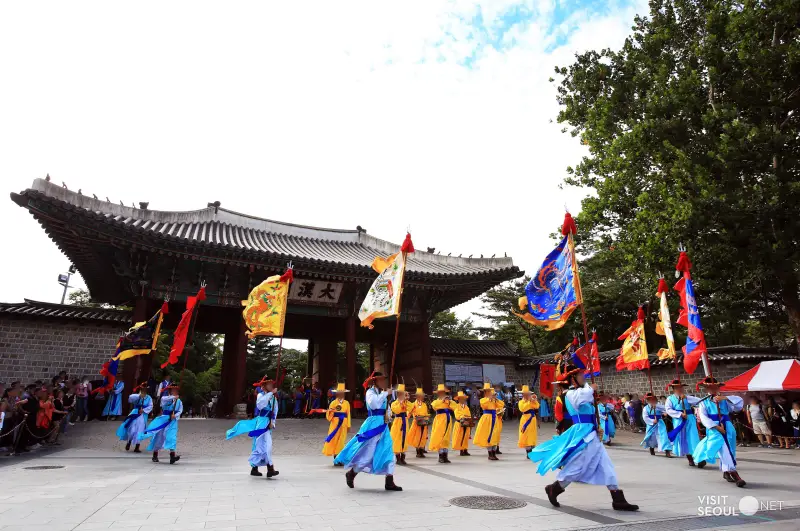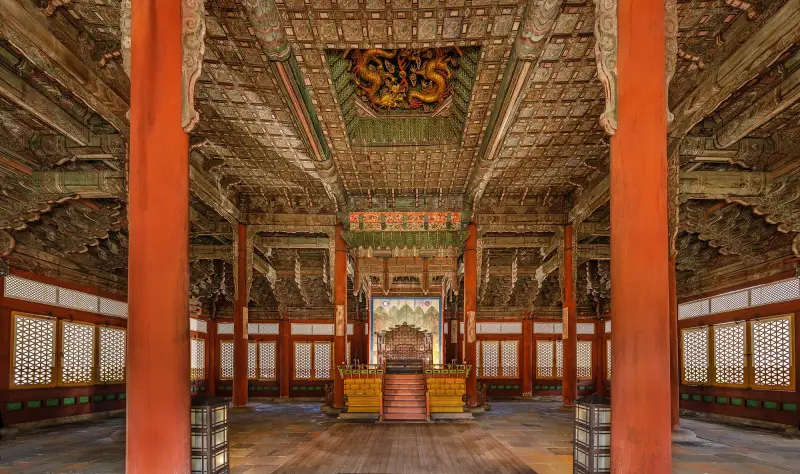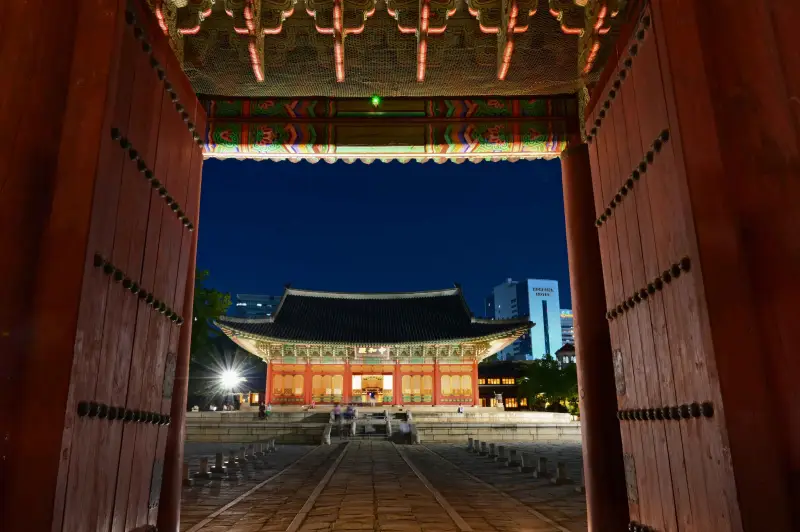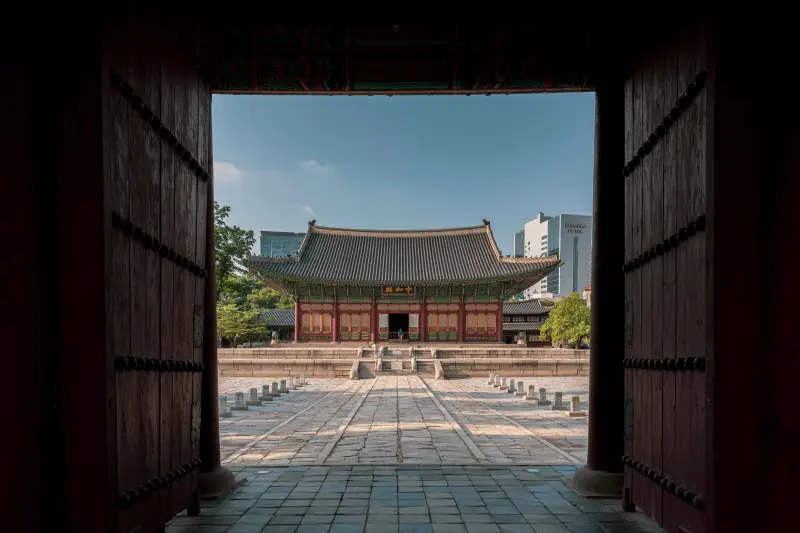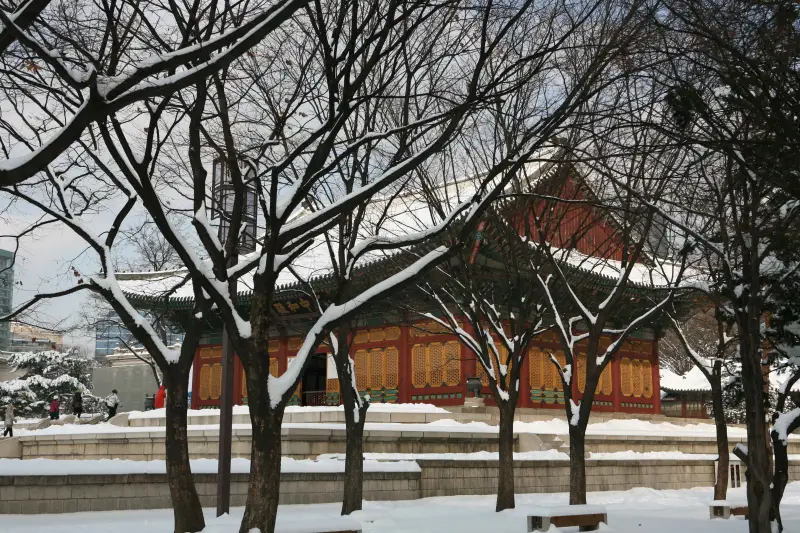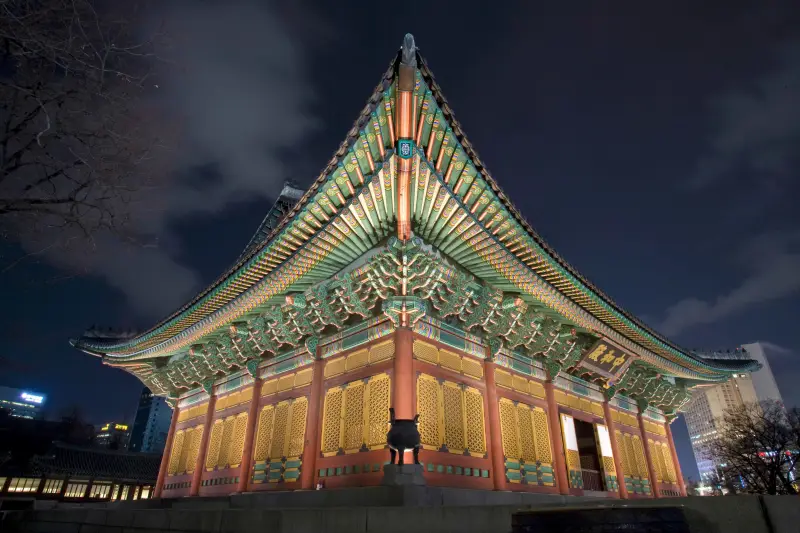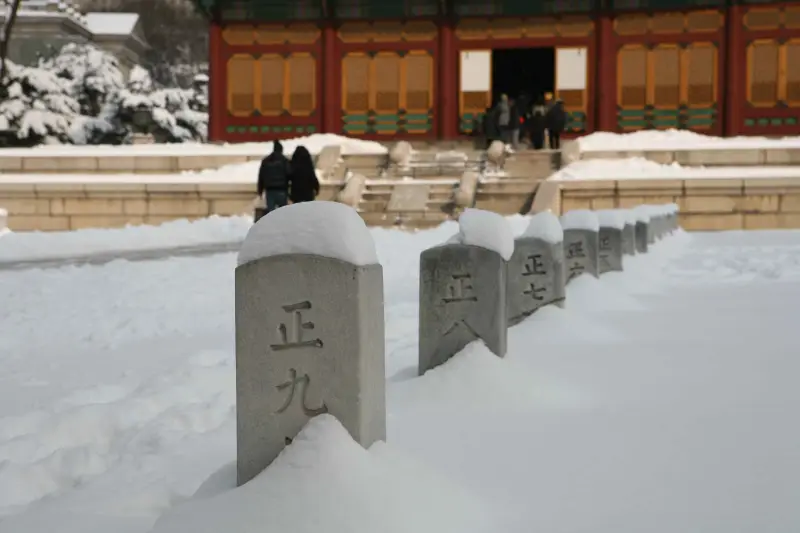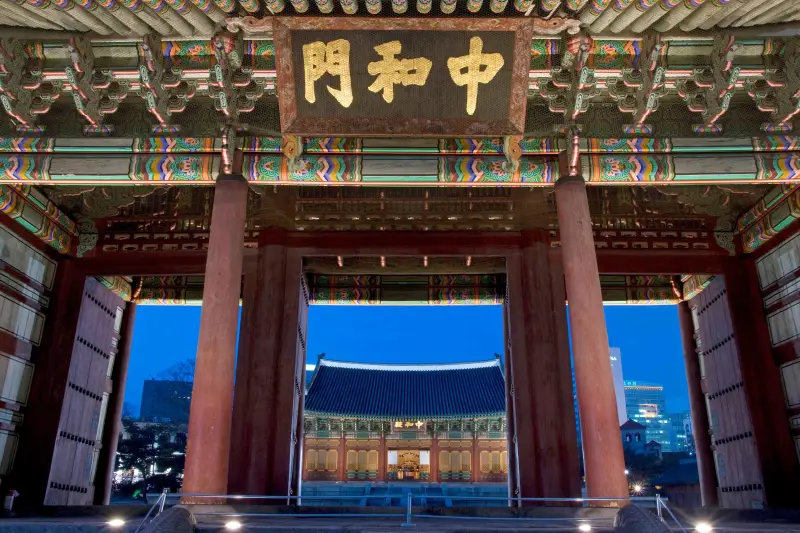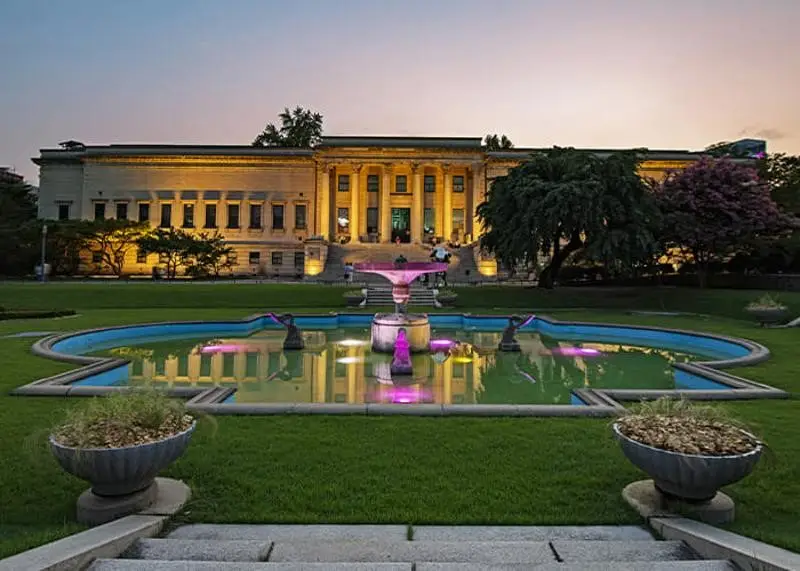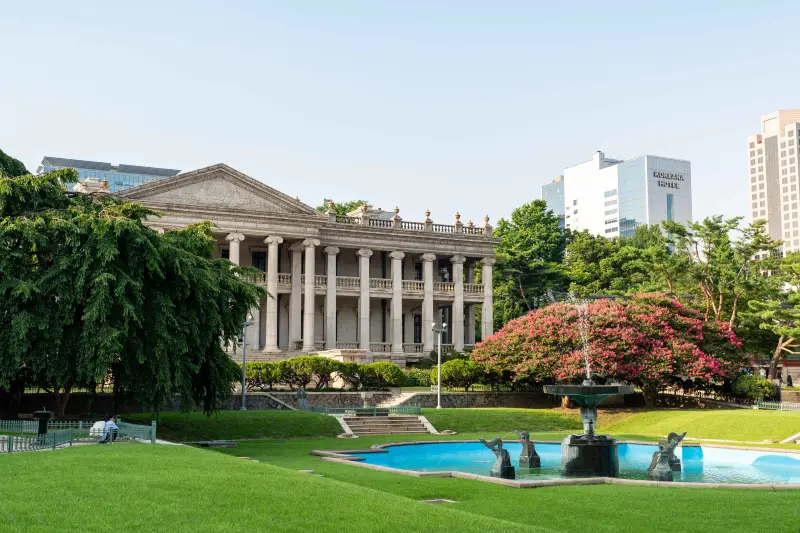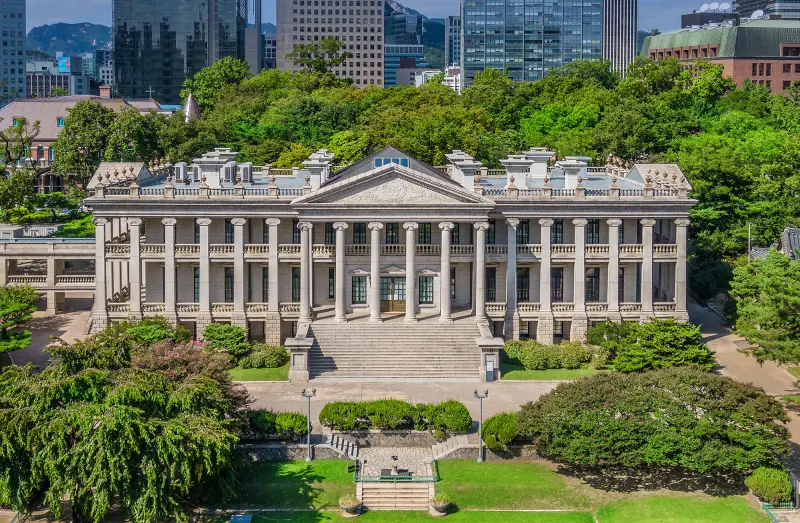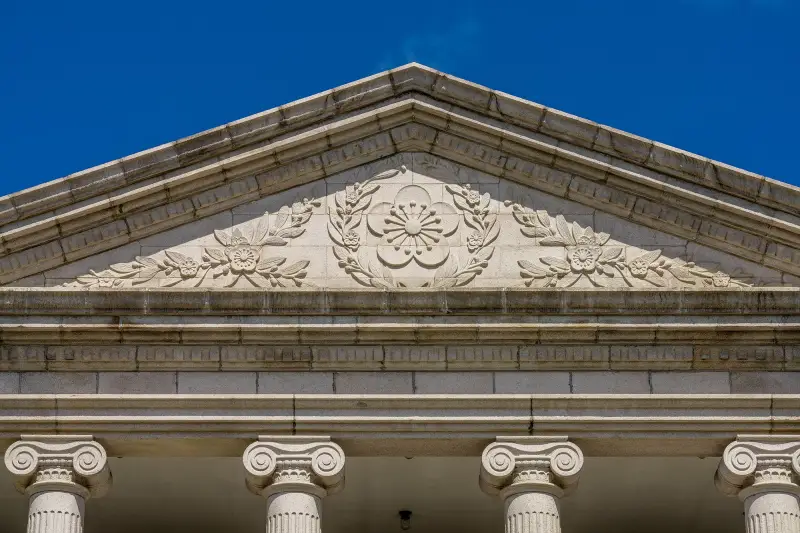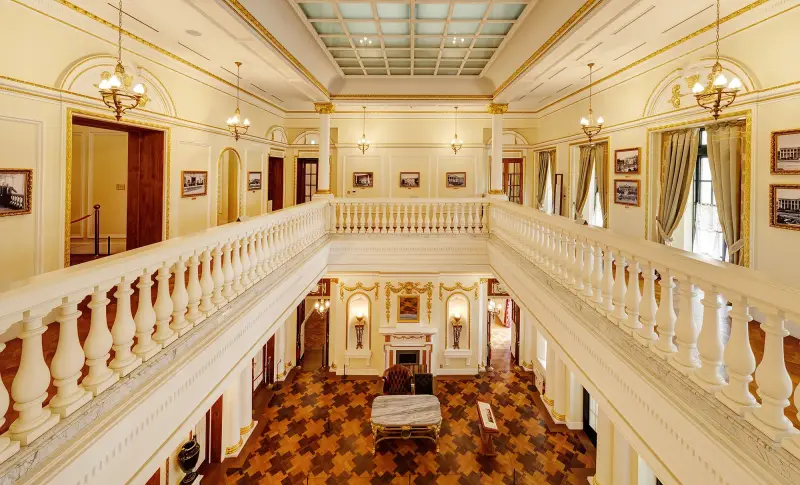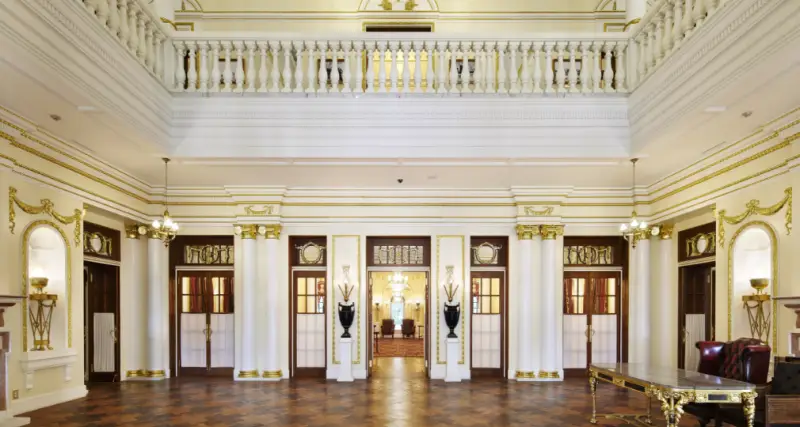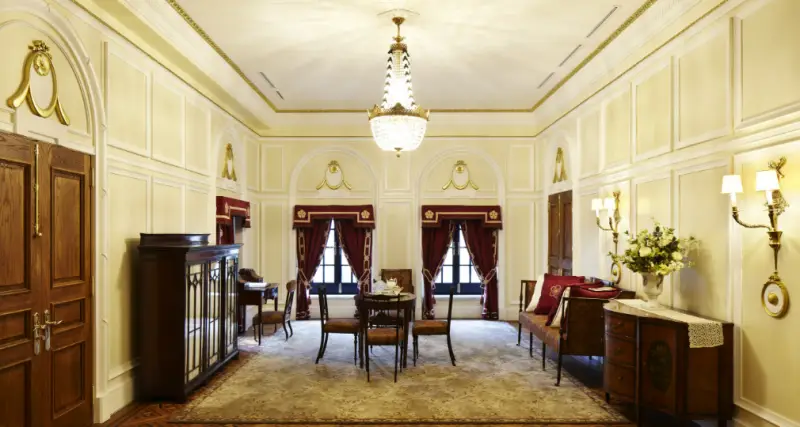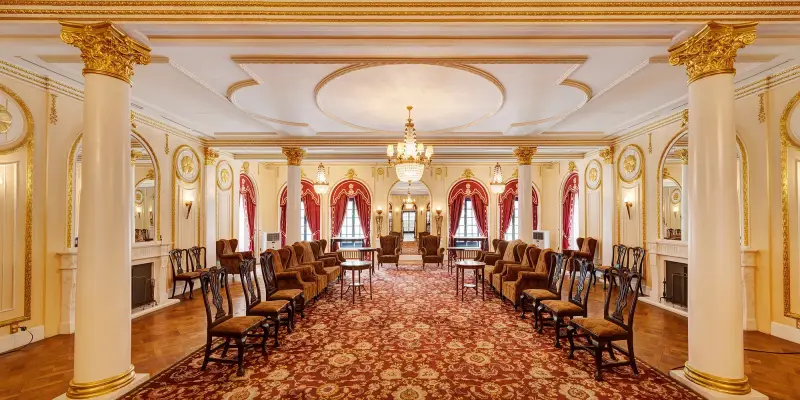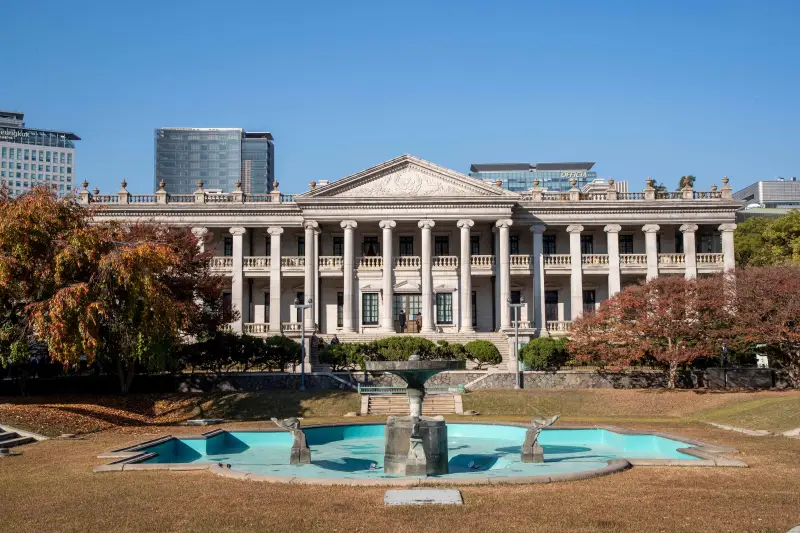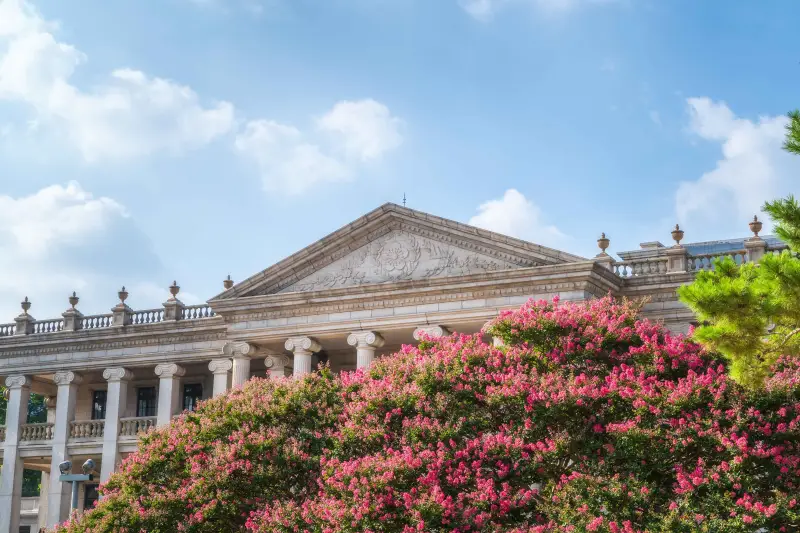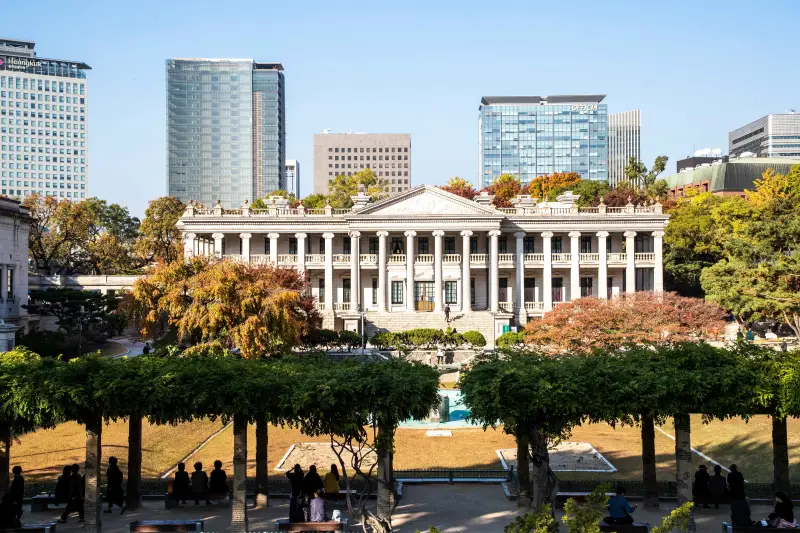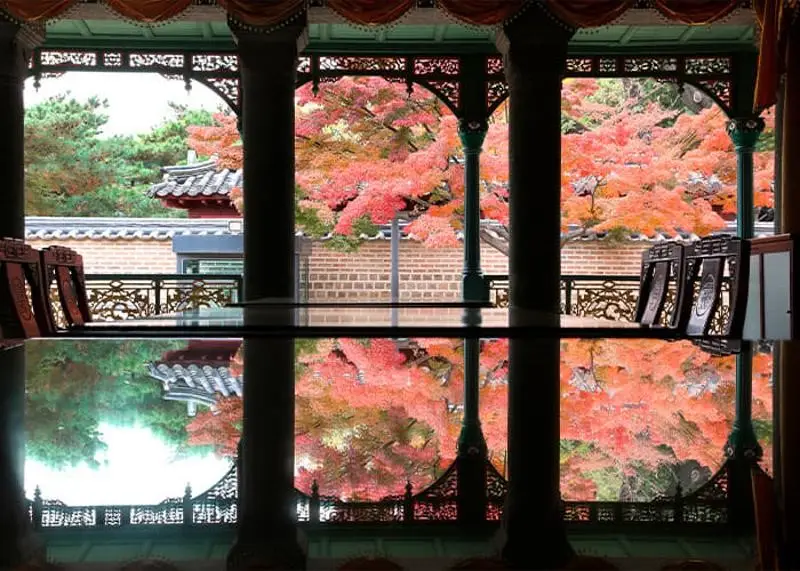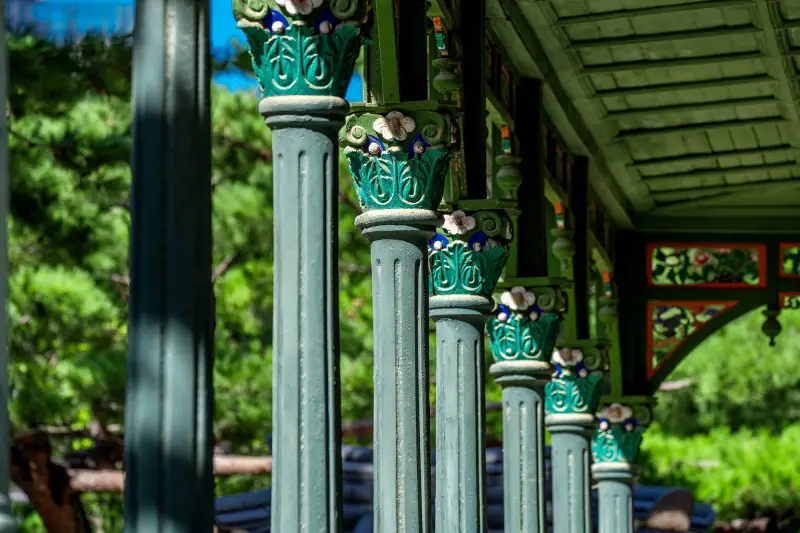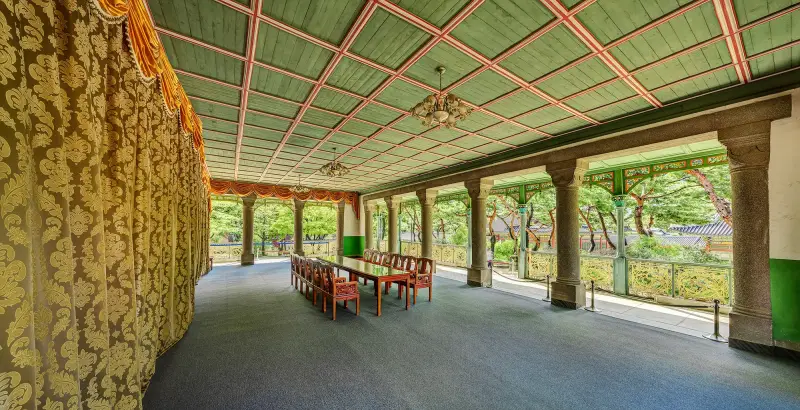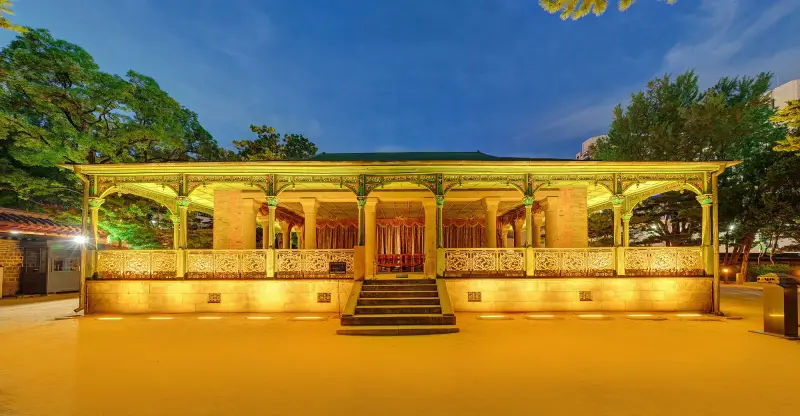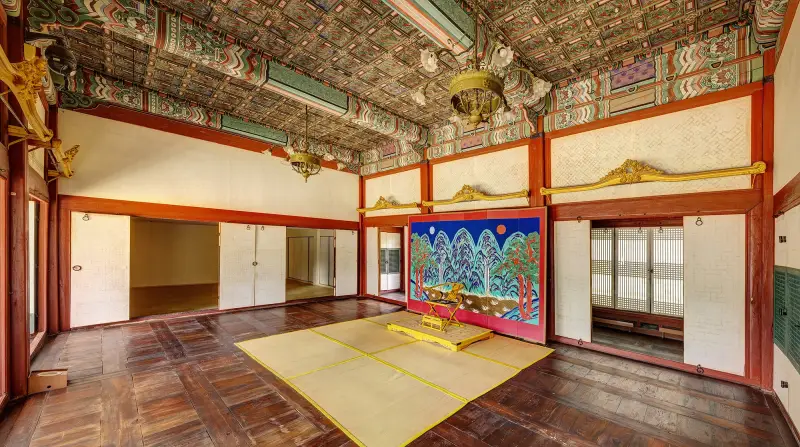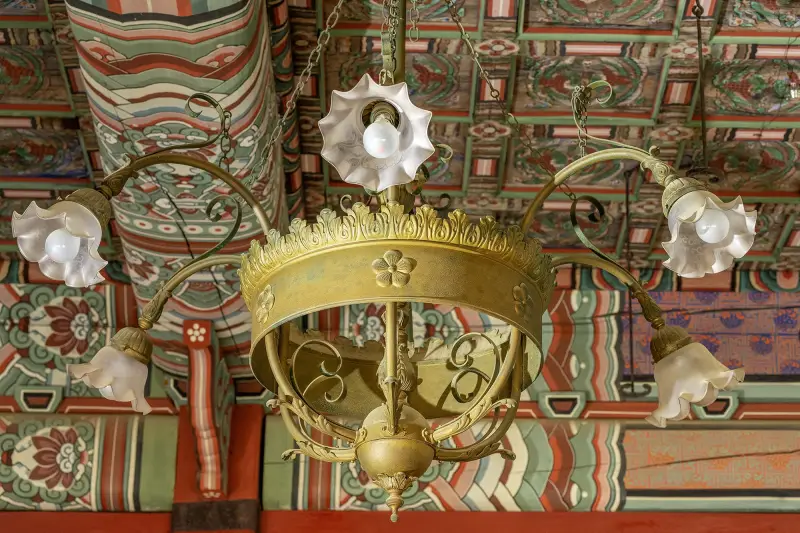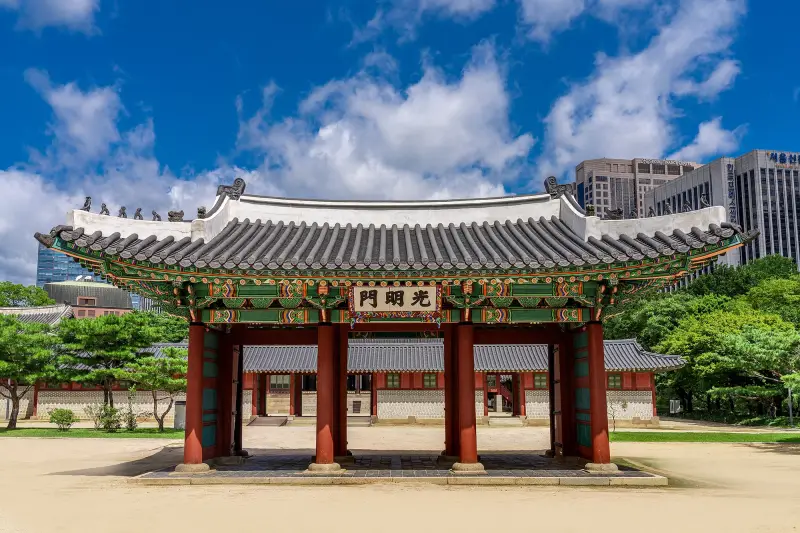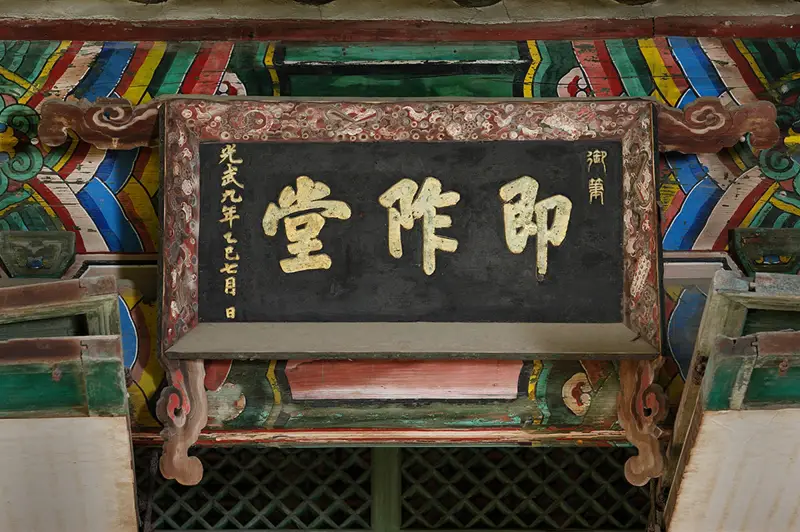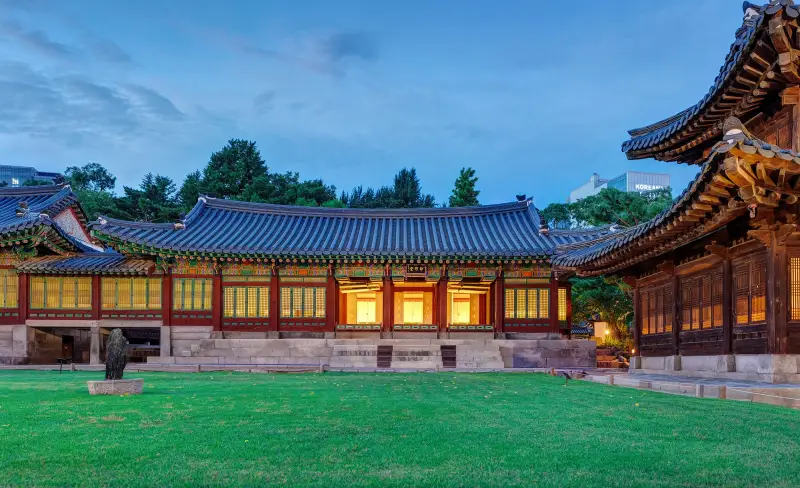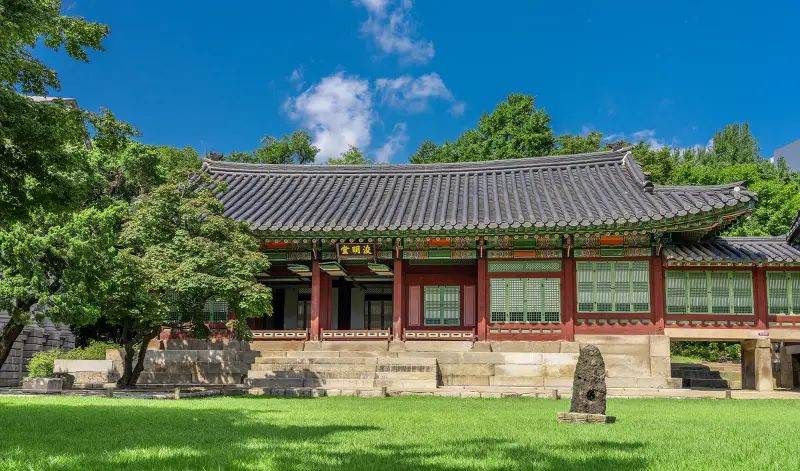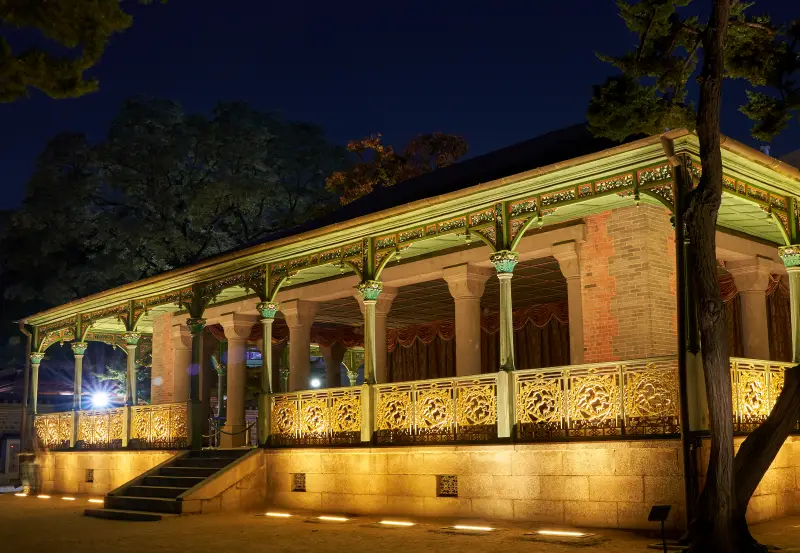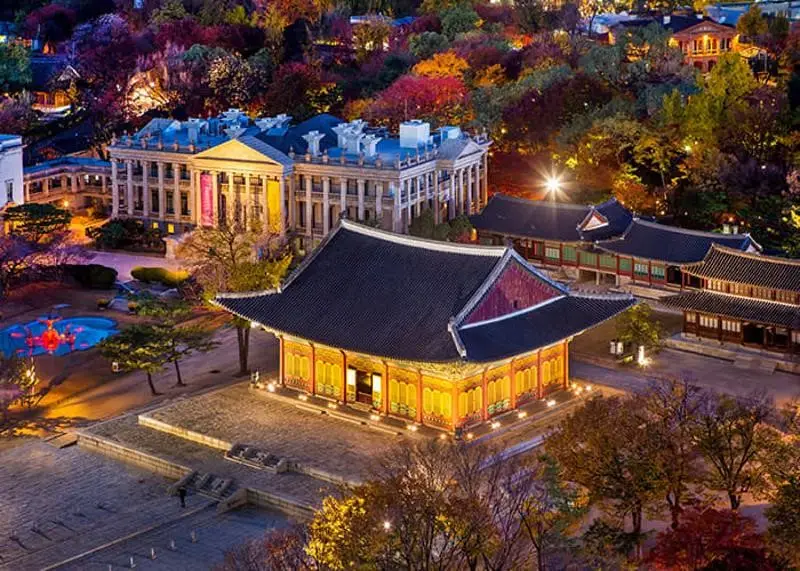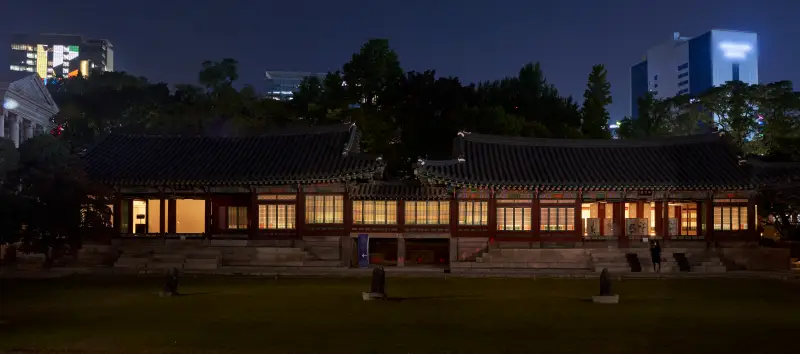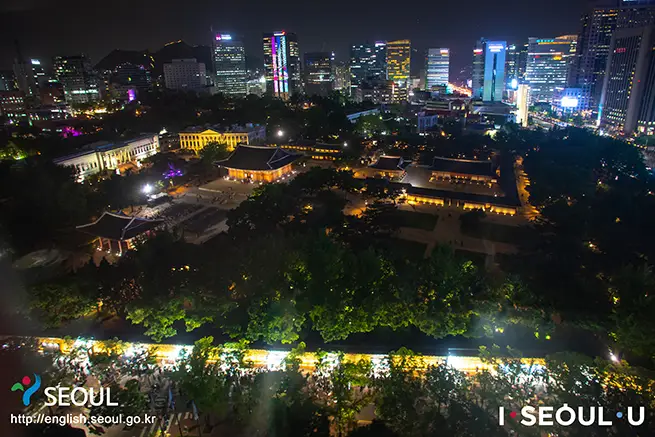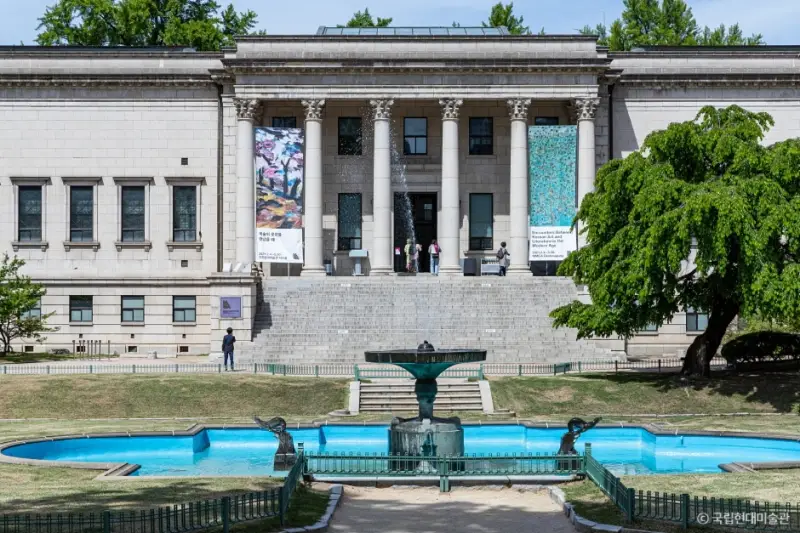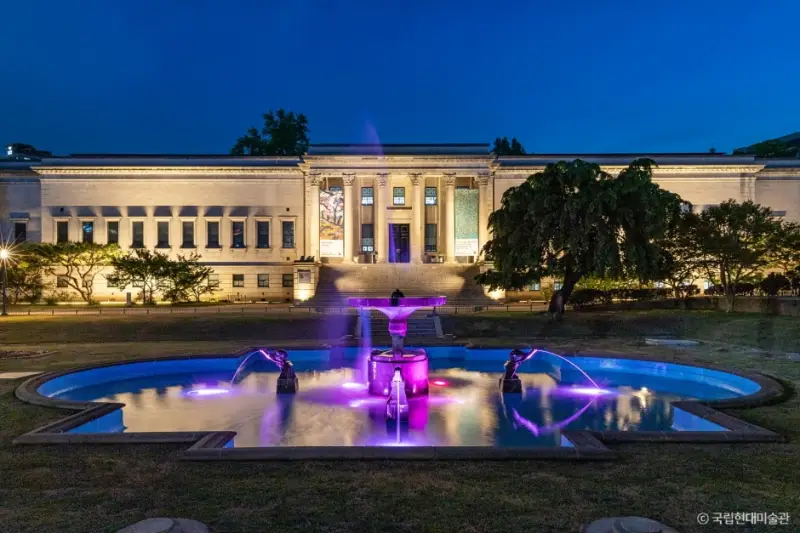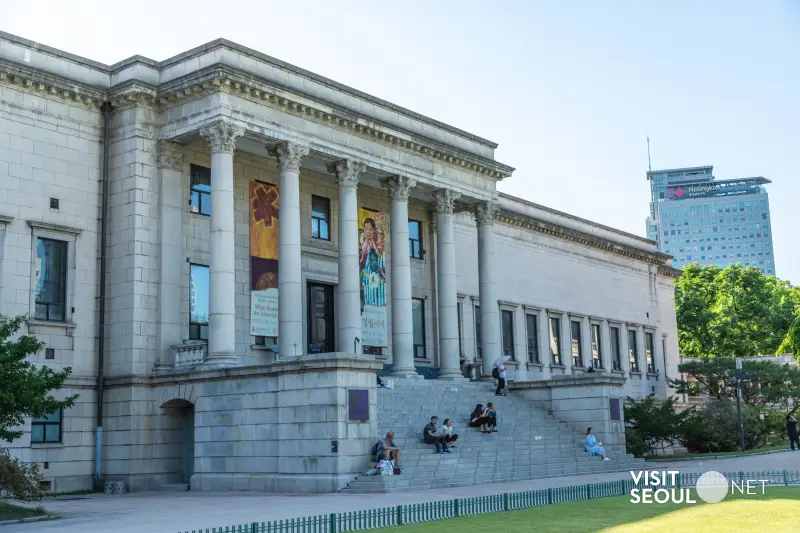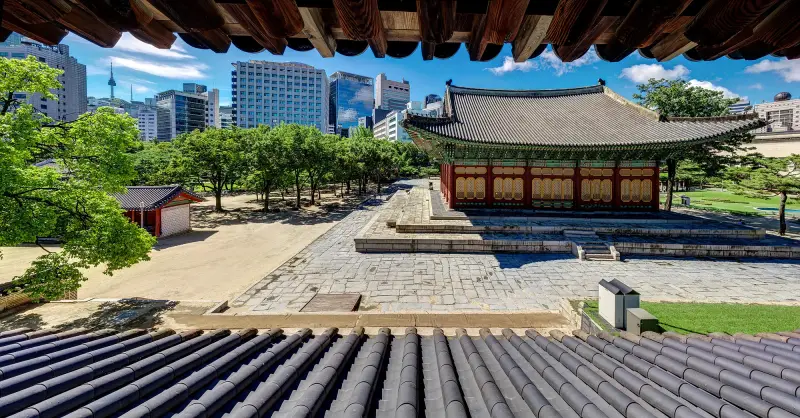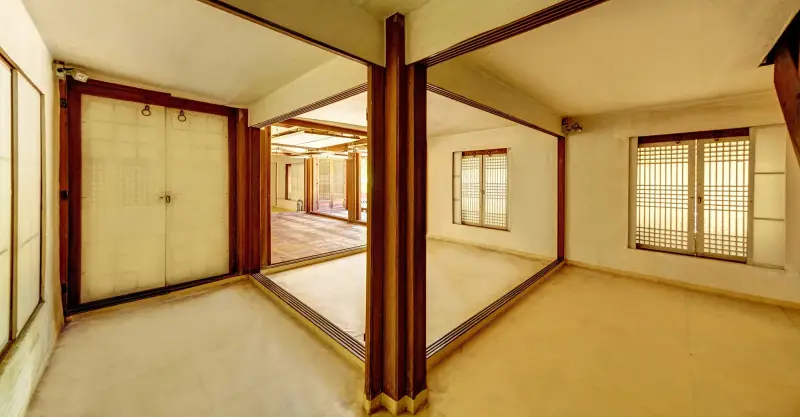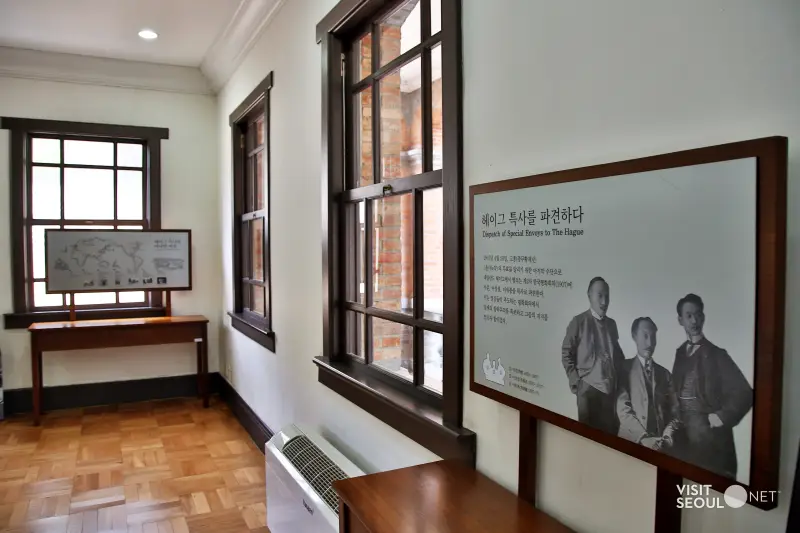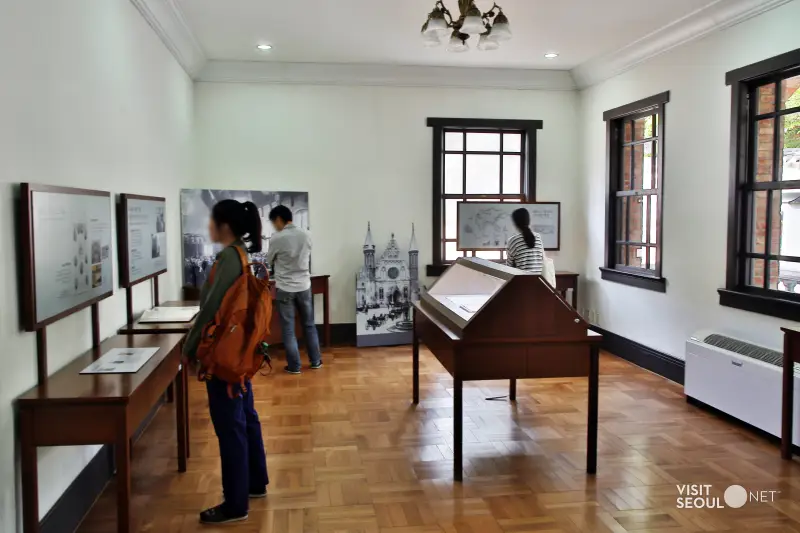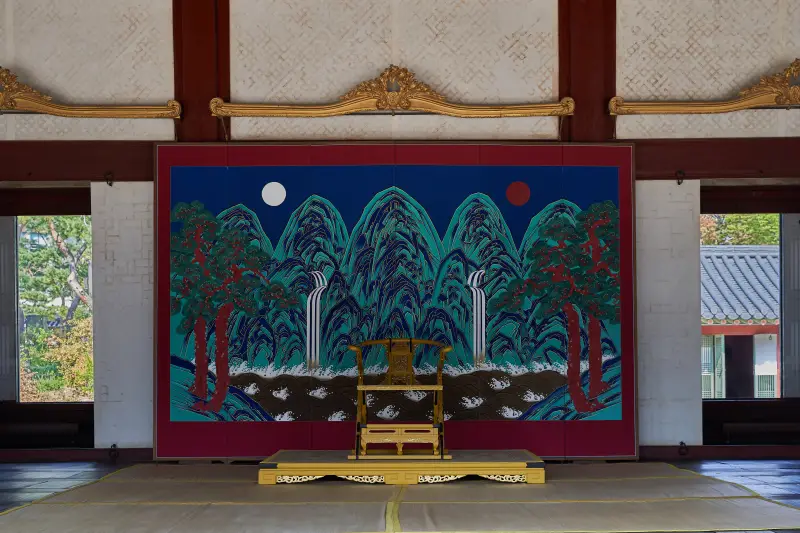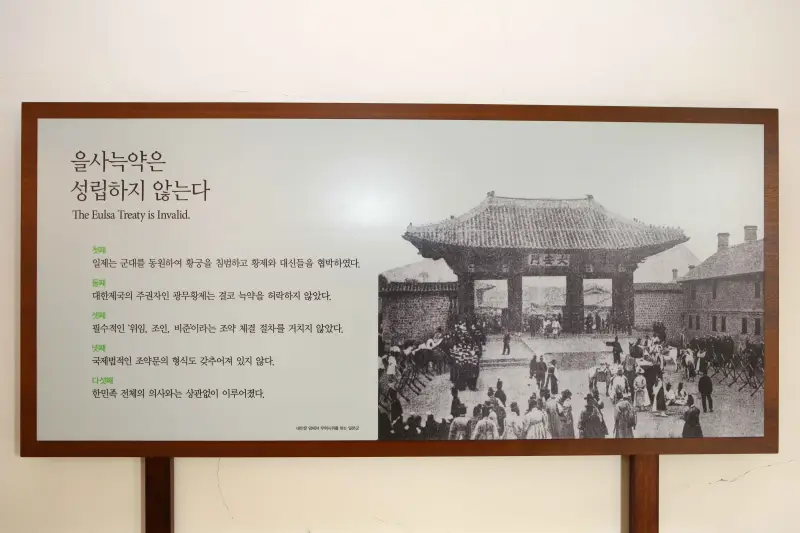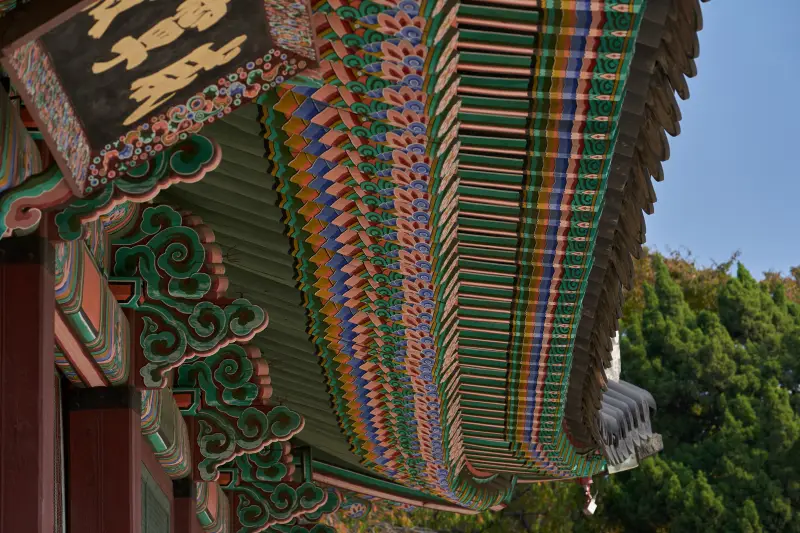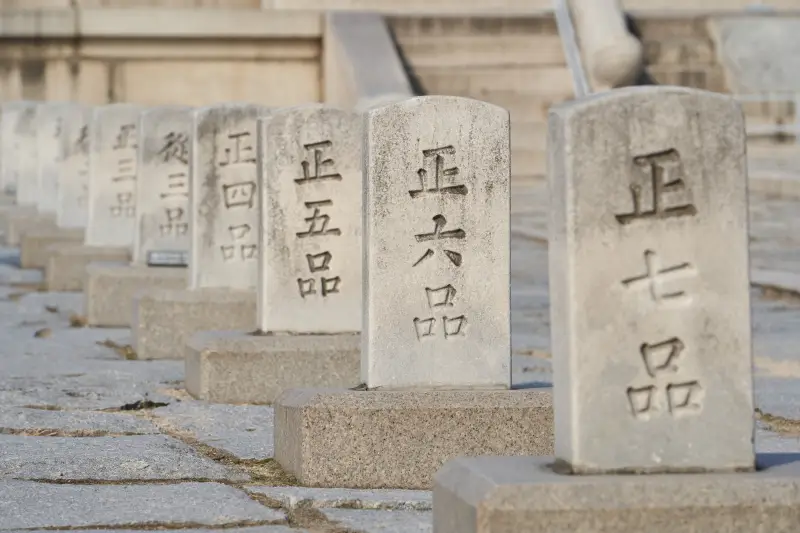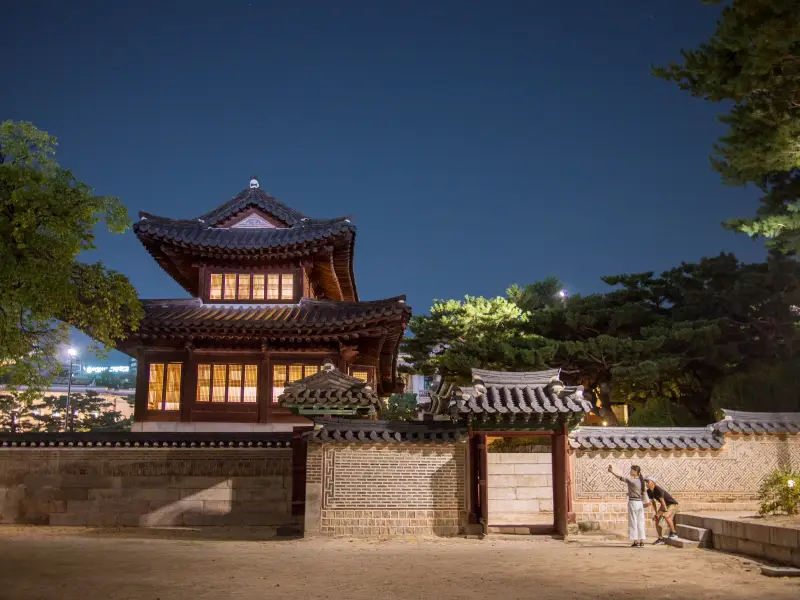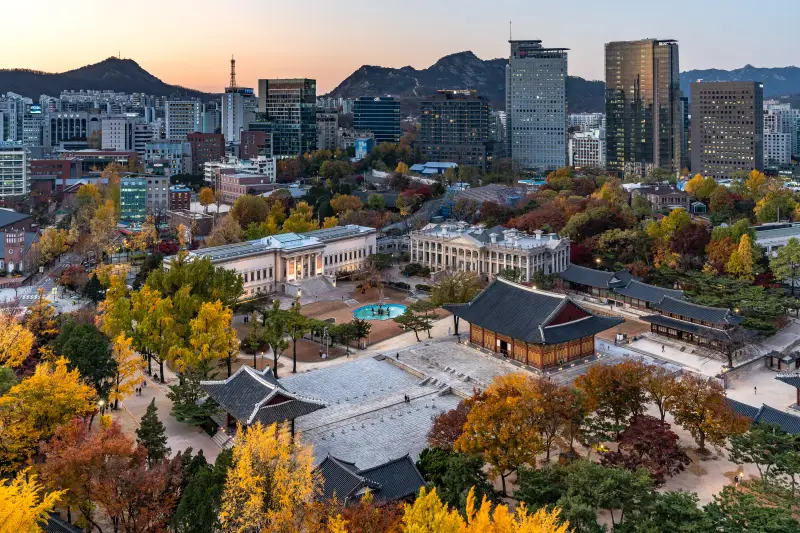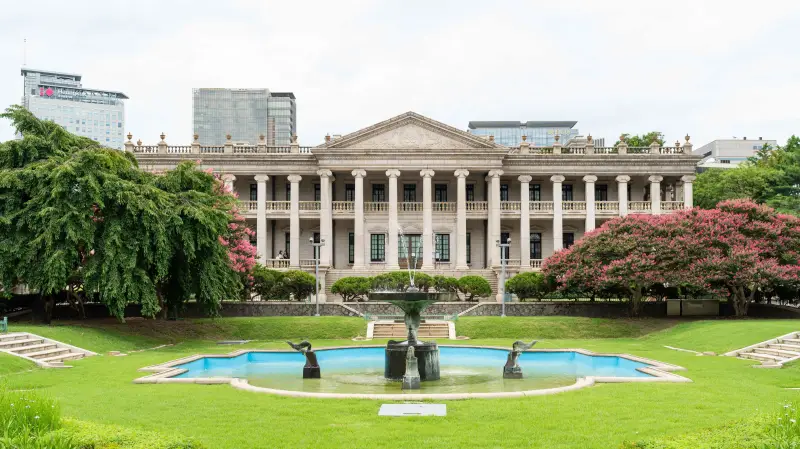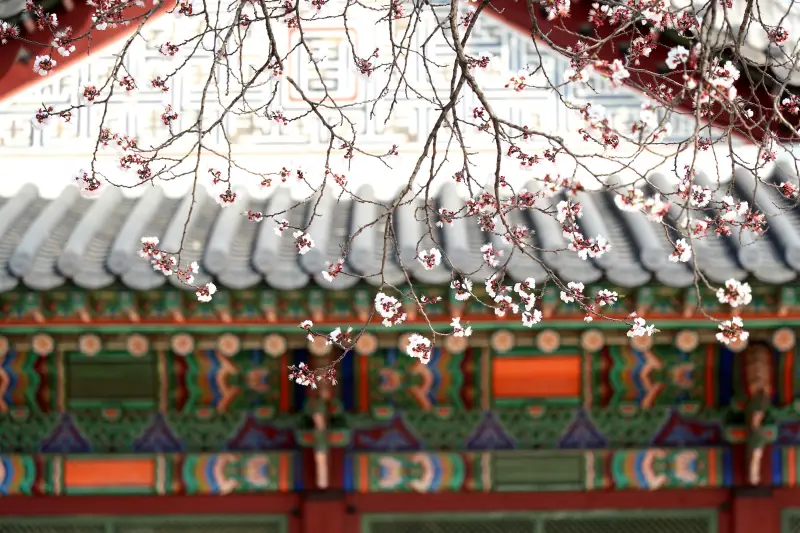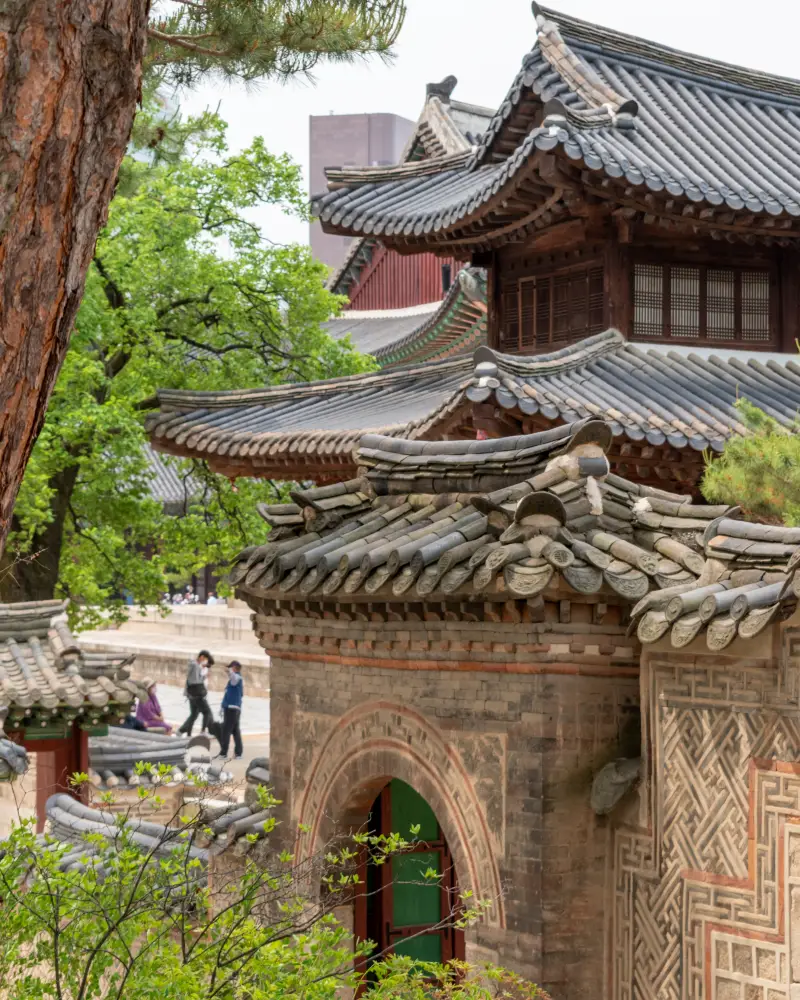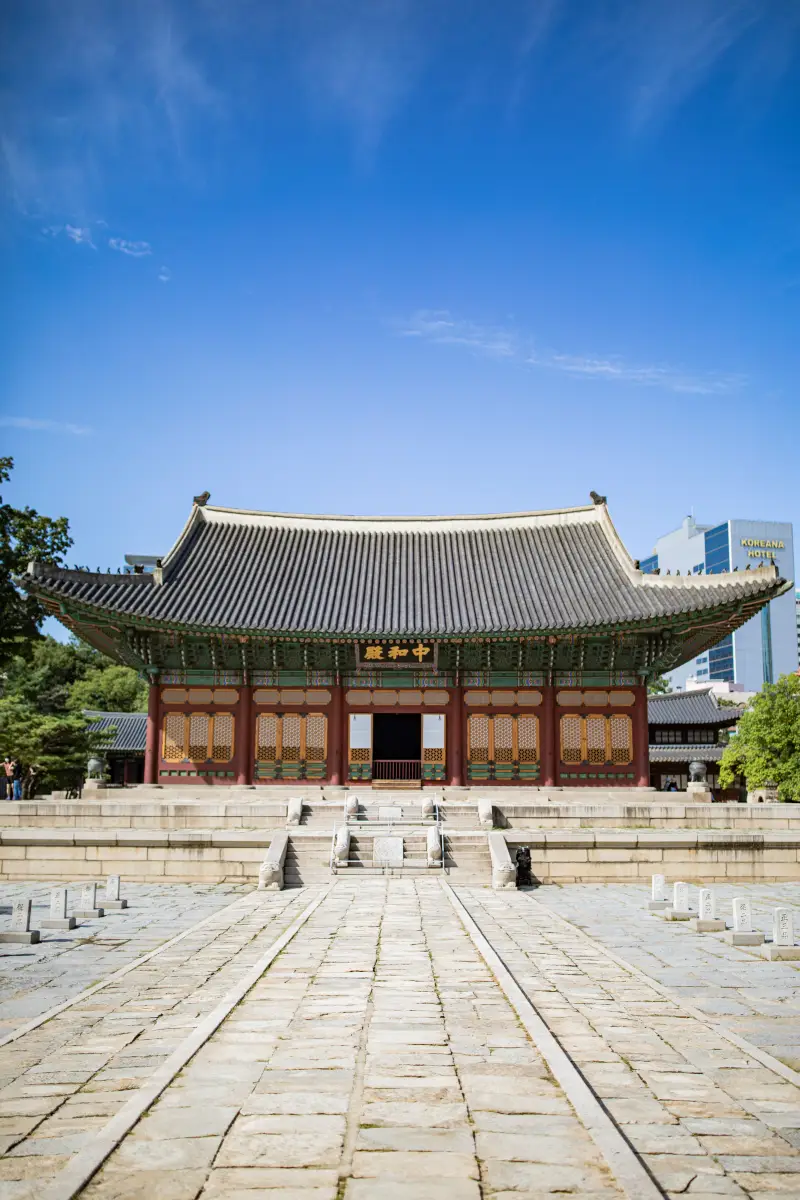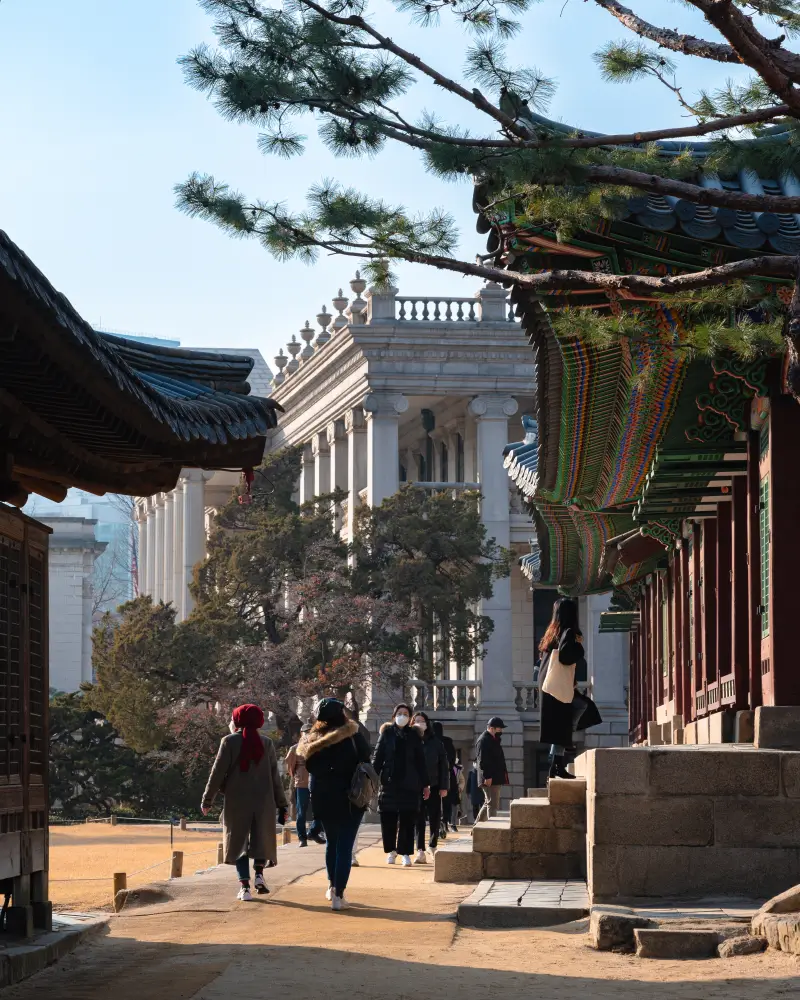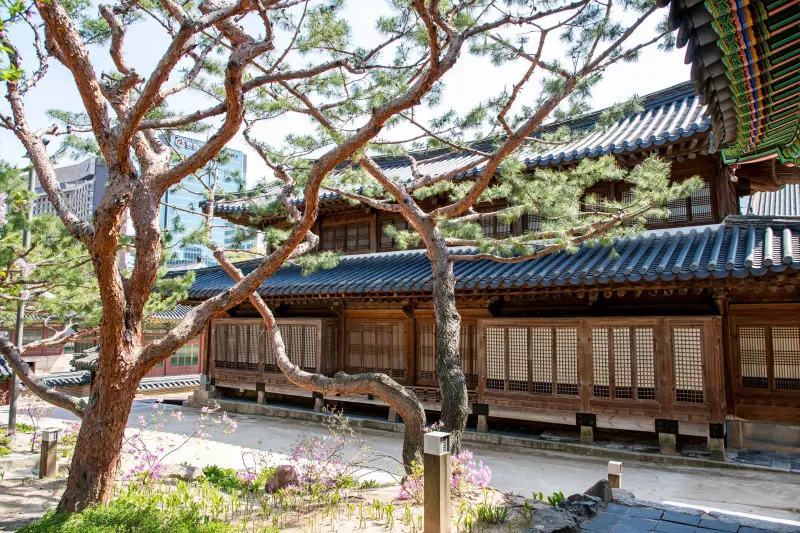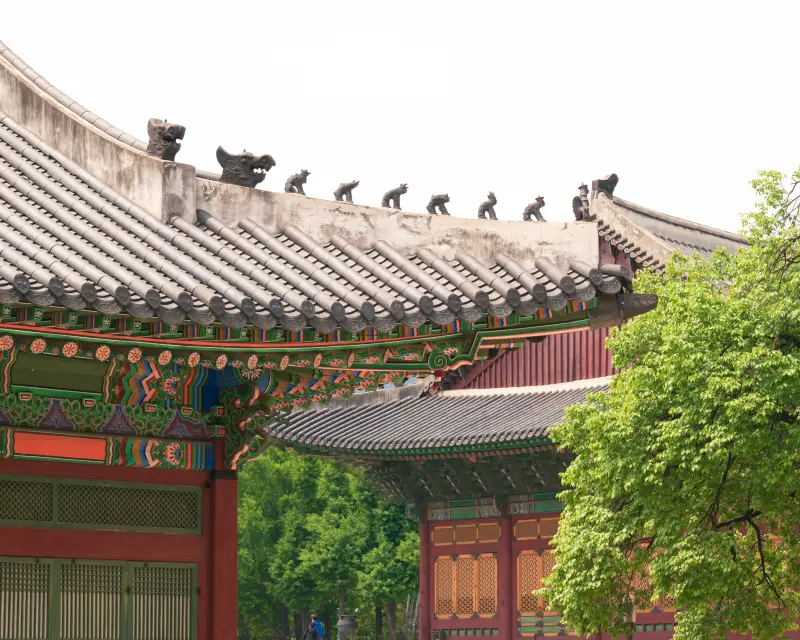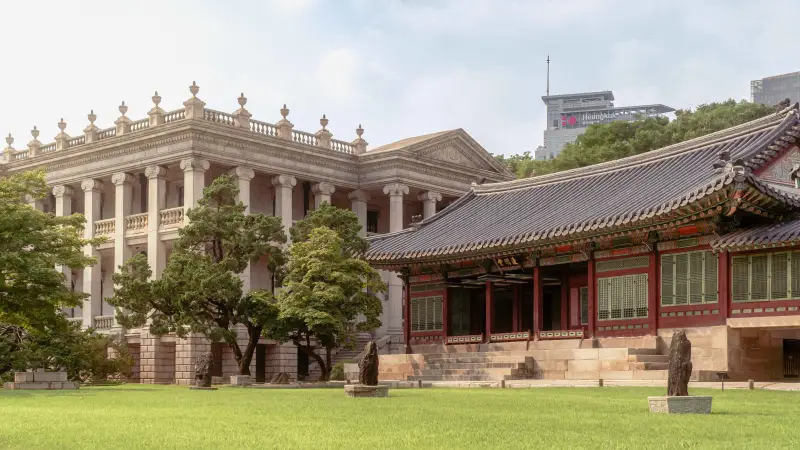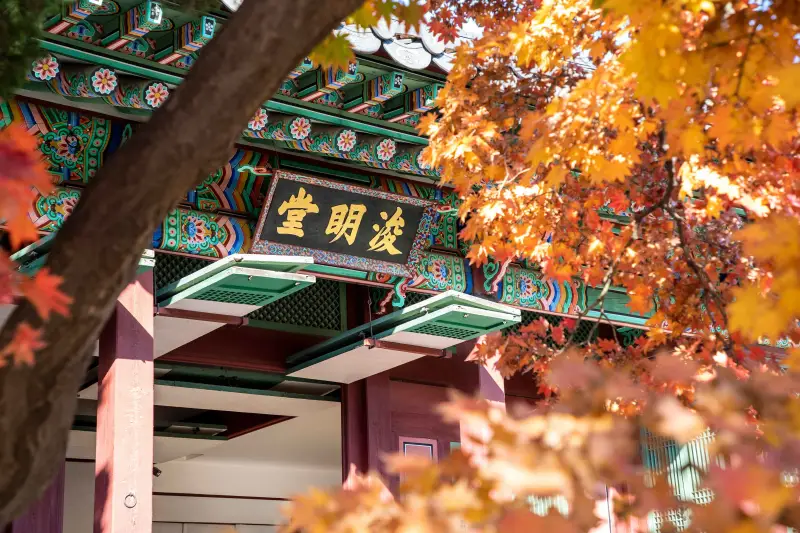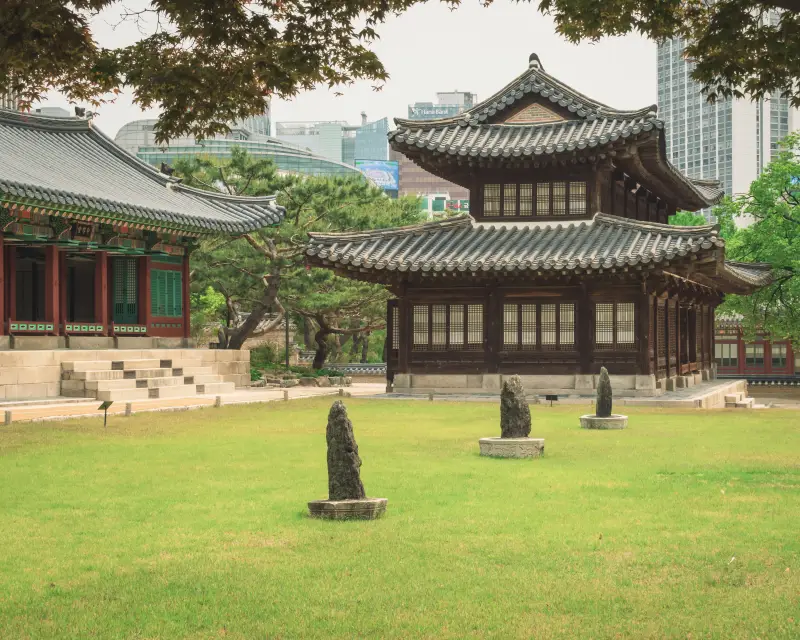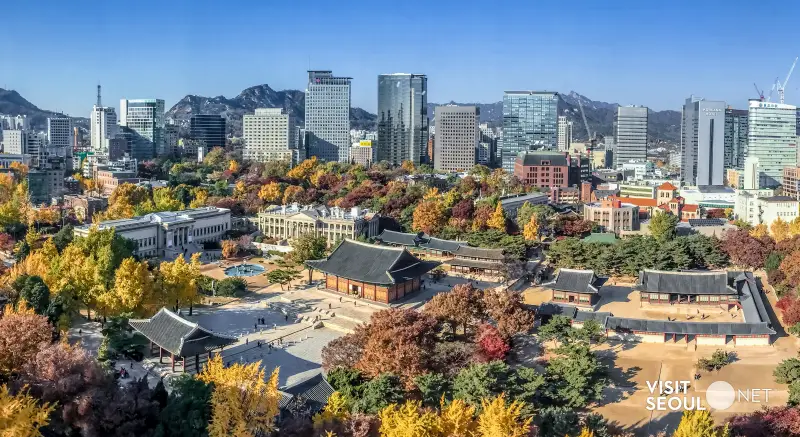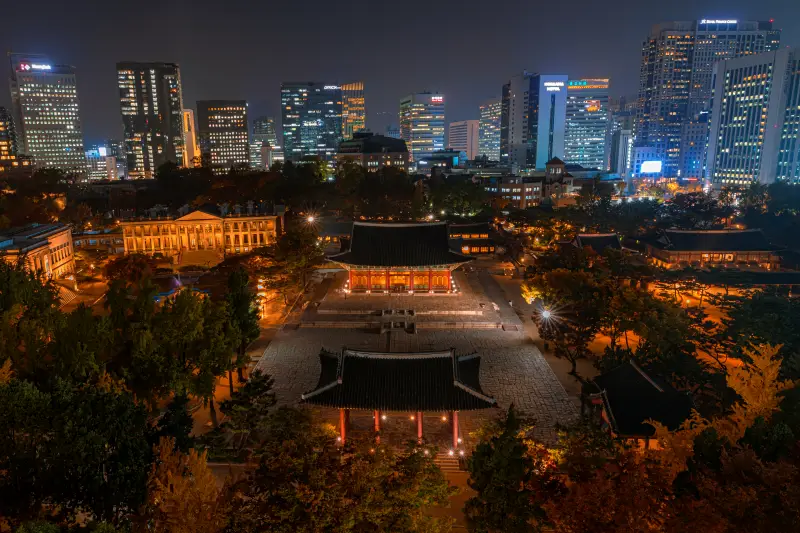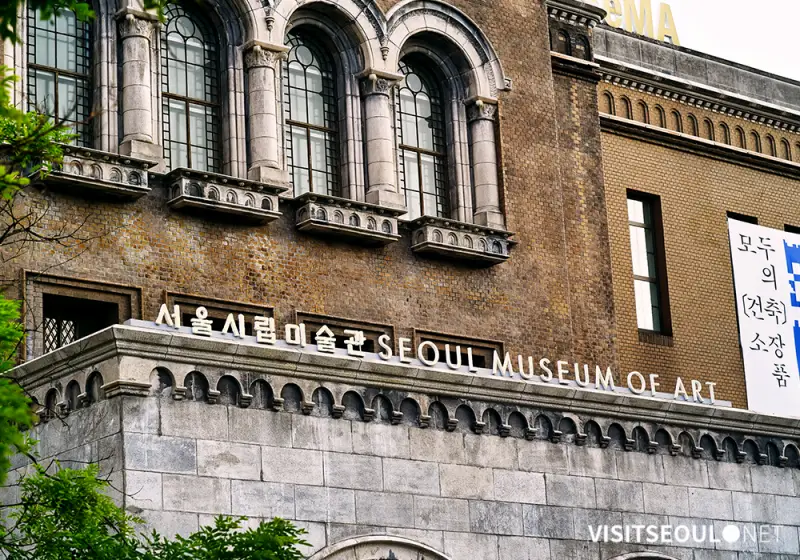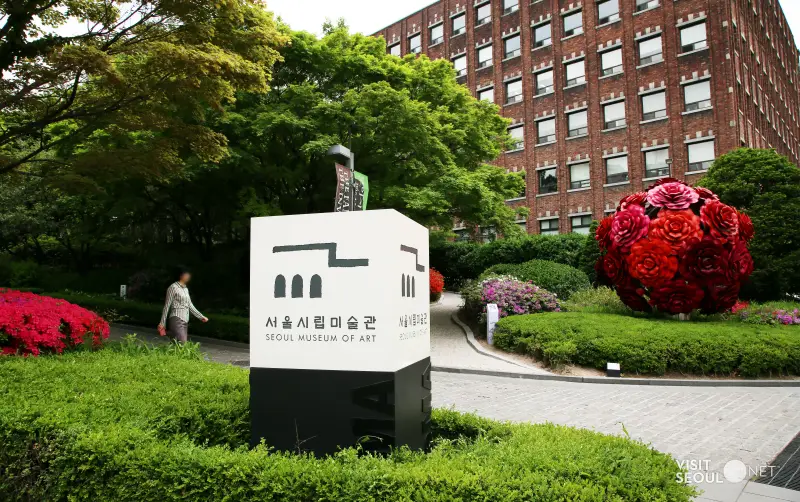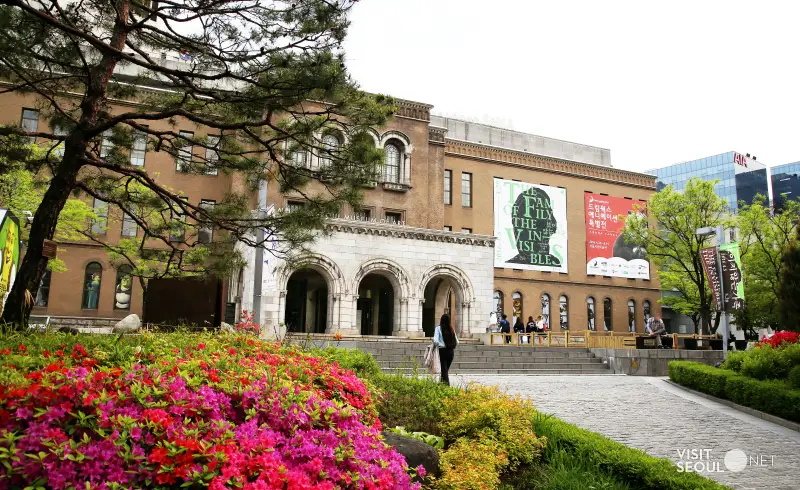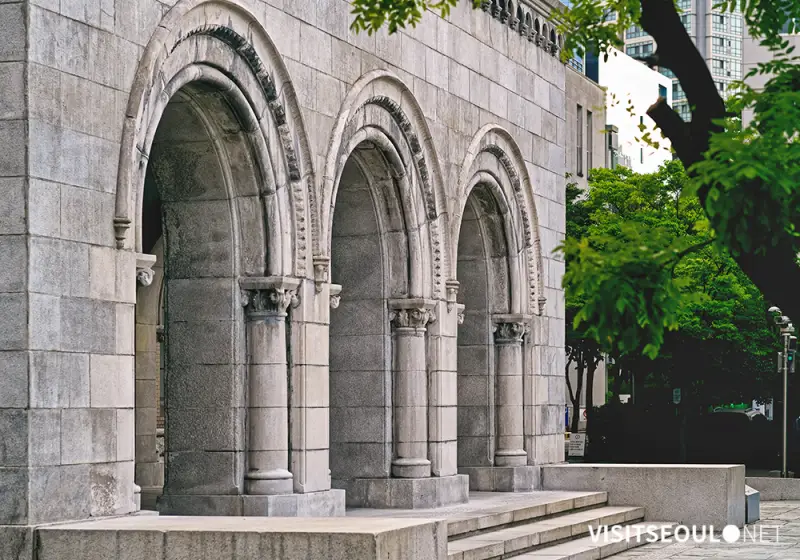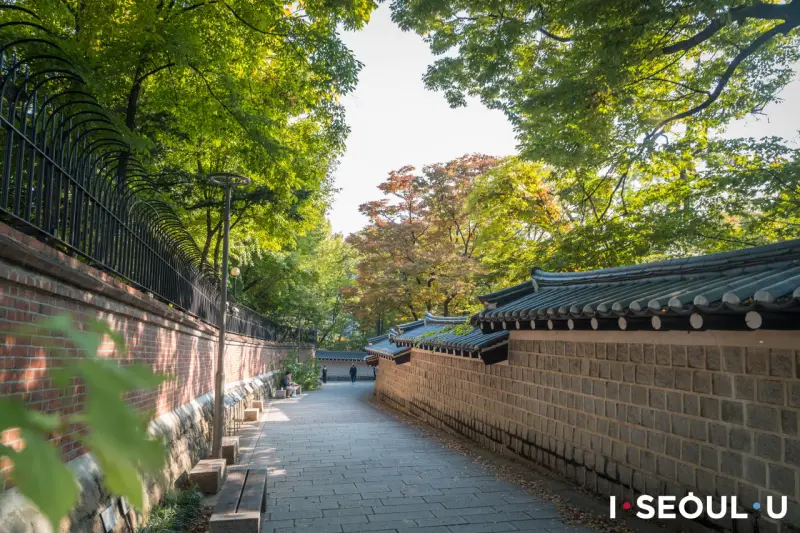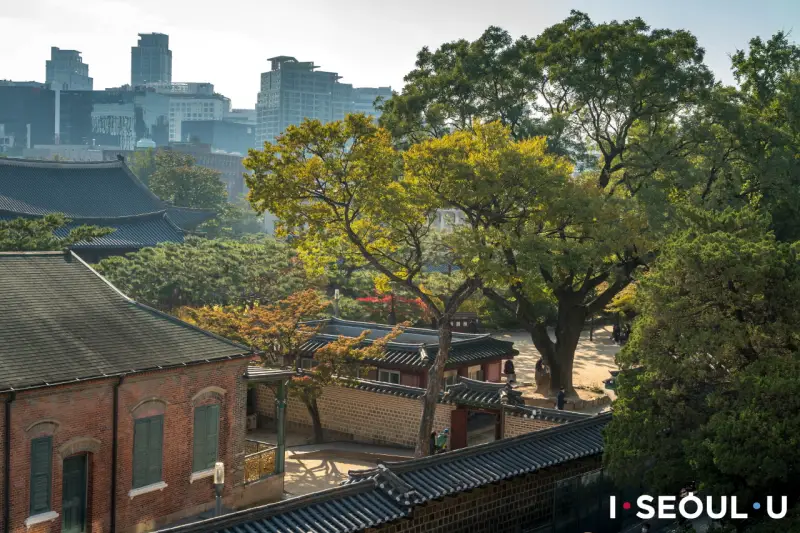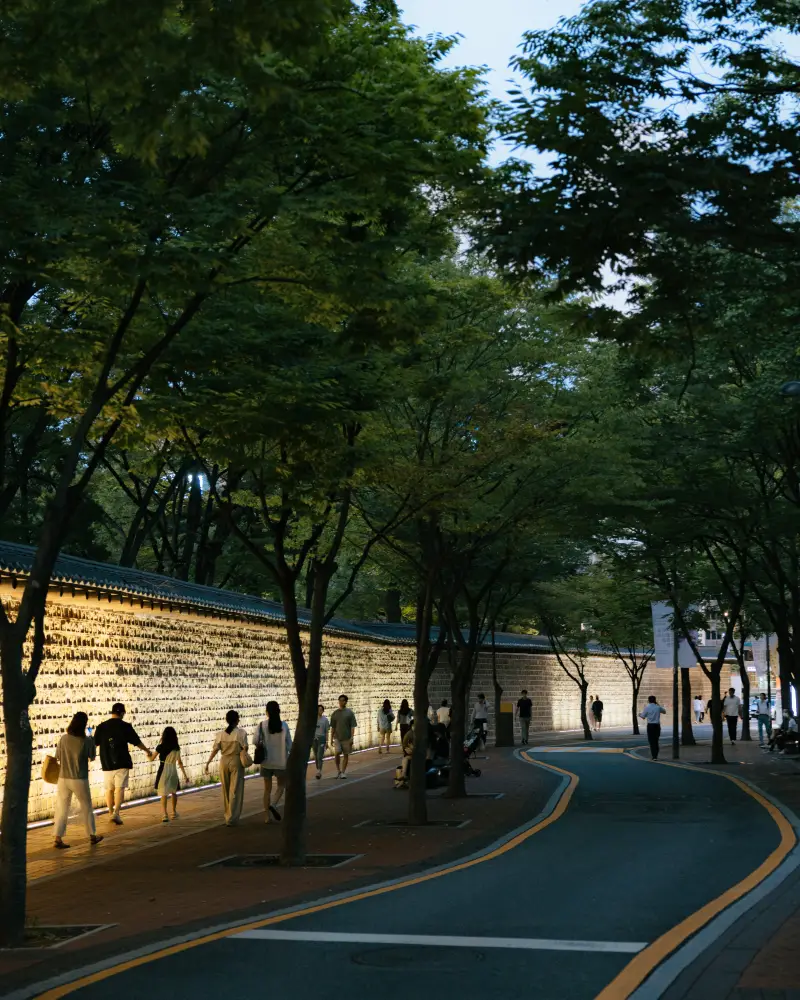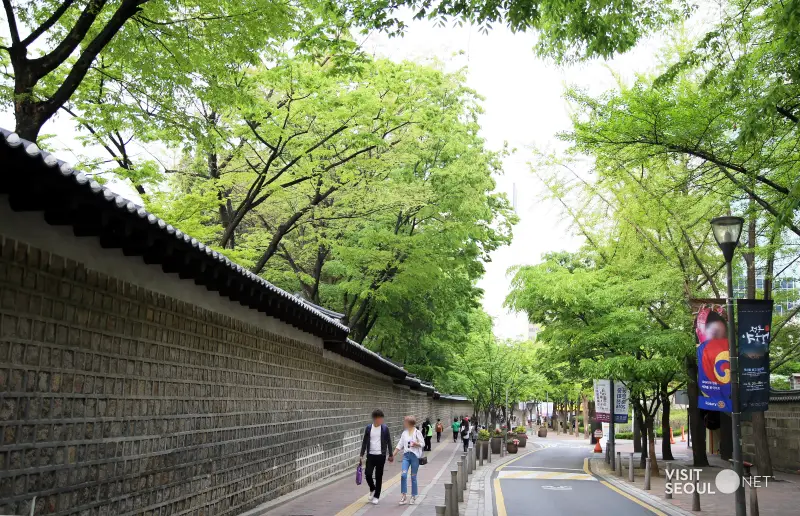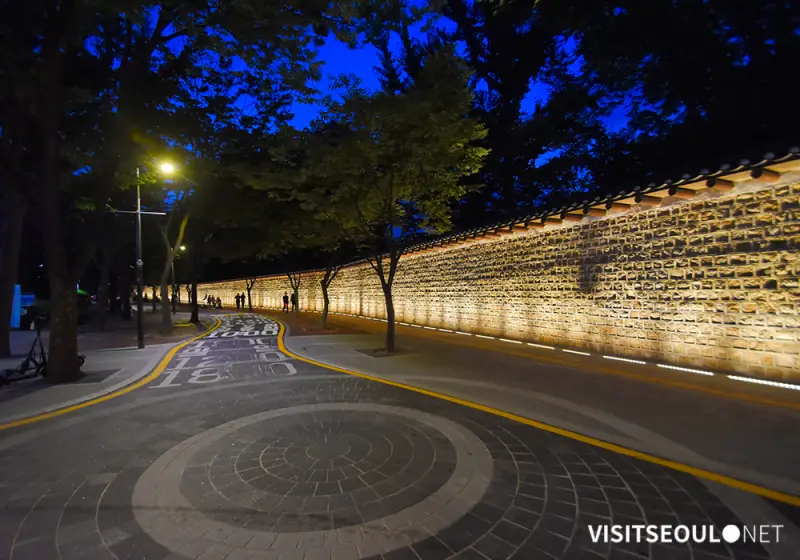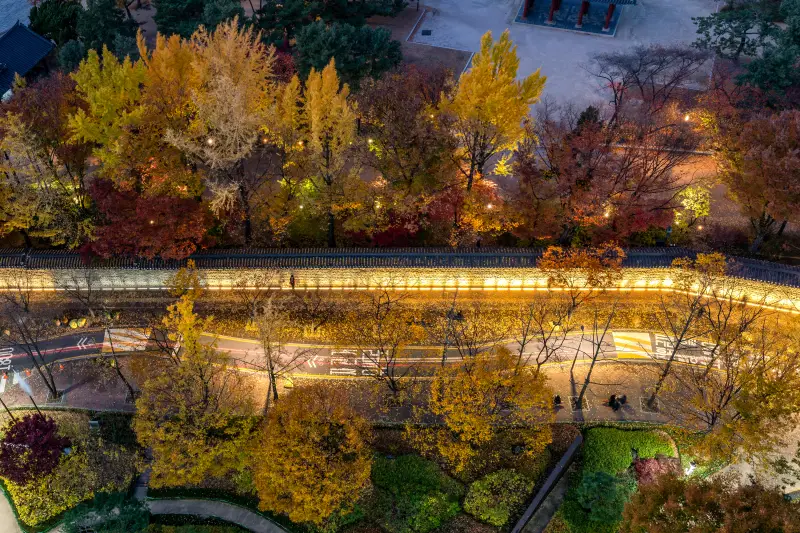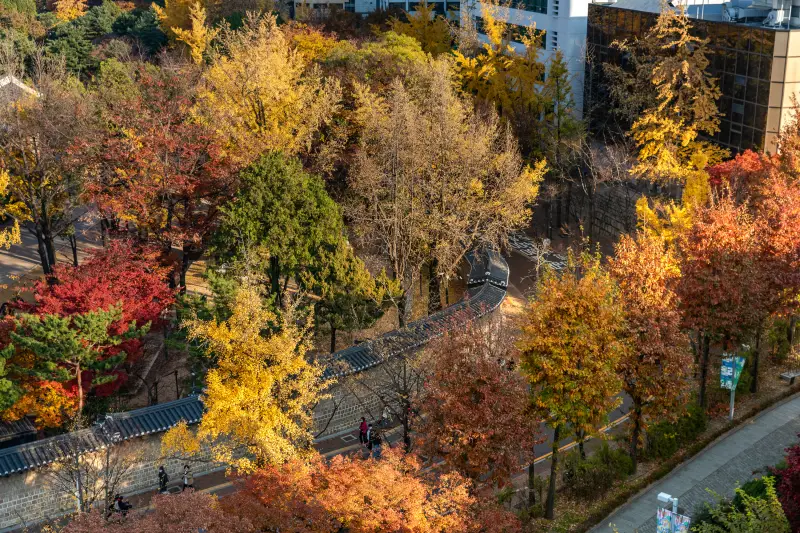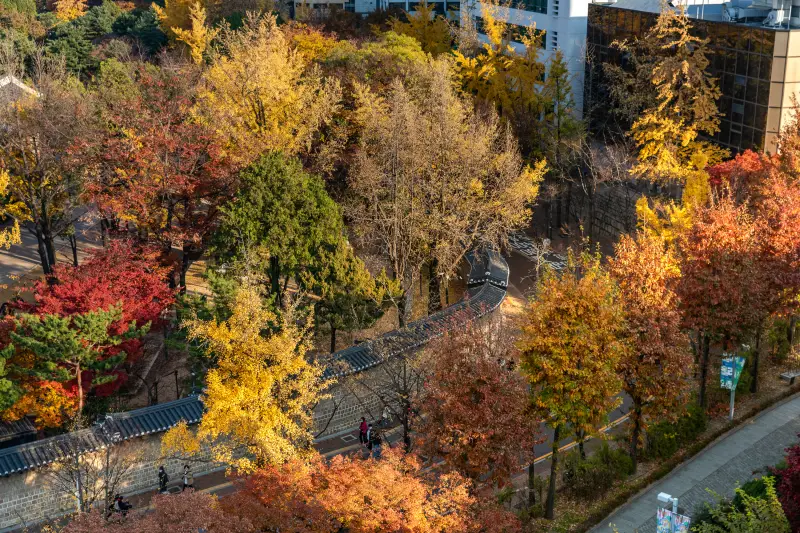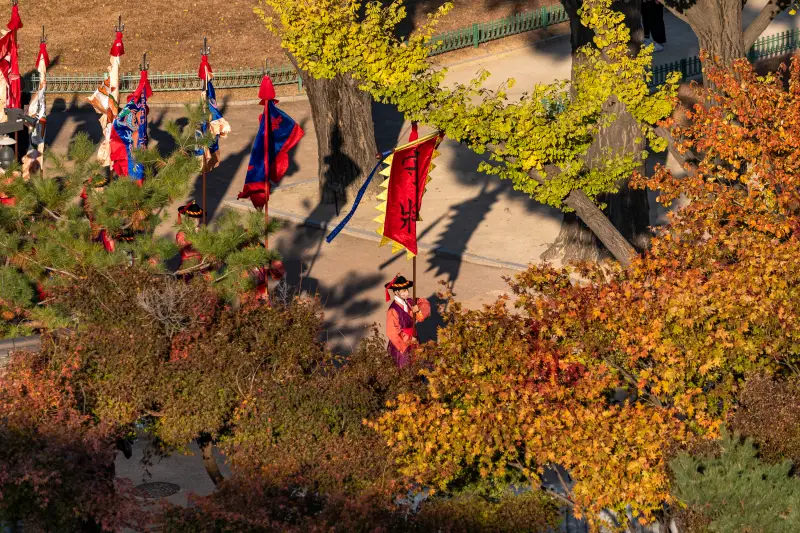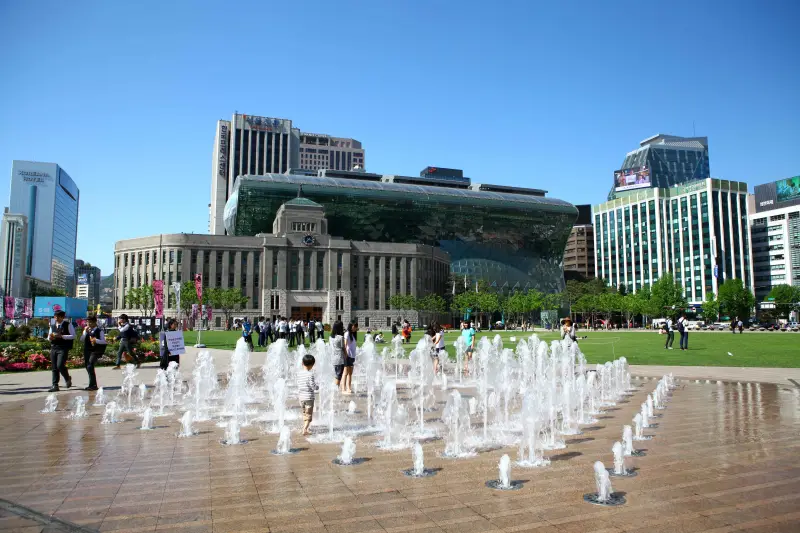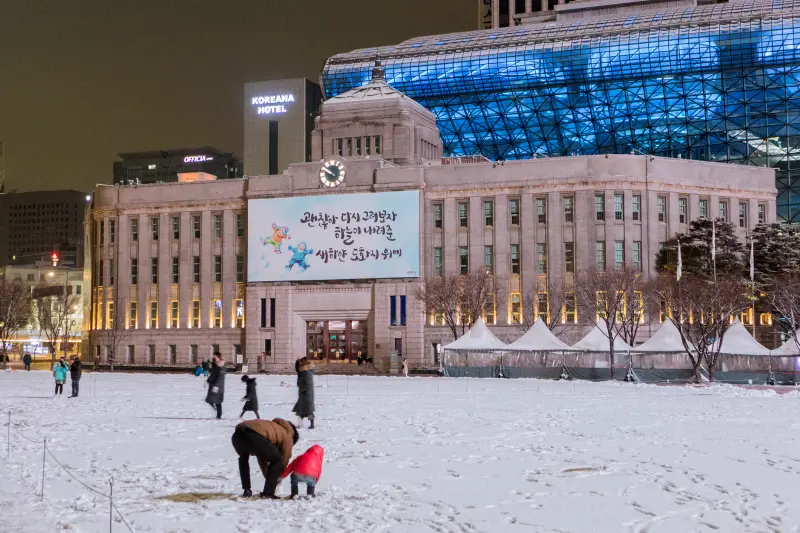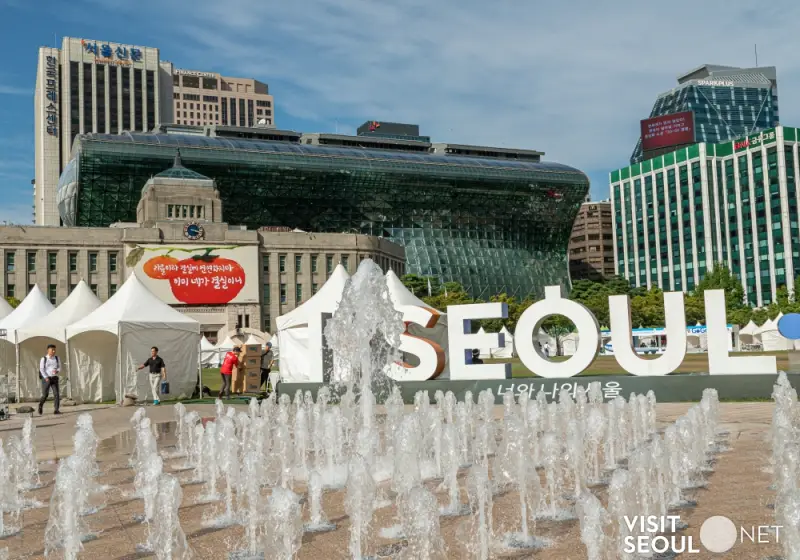Deoksugung Palace
“The last imperial palace of the Joseon Dynasty and Korean Empire, where tradition and modernity coexist in the heart of Seoul’s historic district”
Deoksugung Palace holds a unique value that cannot be found in any other palace. As the last palace of Joseon and the historic site that marked the beginning of the Korean Empire, it serves as a living museum that perfectly captures the transitional period of Korean history.
1. Overview
Introduction to
Deoksugung Palace
- What It’s Like
- At a Glance
What is Deoksugung Like?

Deoksugung Palace, located in Jung-gu’s Jeong-dong area of Seoul, stands as the last palace of the Joseon Dynasty and the imperial palace of the Korean Empire, embodying 500 years of Joseon Dynasty’s historical transitions.
Originally the private residence of Prince Wolsan, it became a palace when King Seonjo moved to this civilian residence in Jeong-dong after all other palaces were burned down during the Japanese invasion of 1593. At that time, it was known as Gyeongungung Palace.
Deoksugung Palace is particularly significant as it was where Emperor Gojong of the Korean Empire resided the longest. After the proclamation of the Korean Empire in 1897, it was fully developed into an imperial palace.
Seokjojeon Hall, built during this period, introduced Western architectural styles, presenting a completely different appearance from traditional palace architecture. This coexistence of Eastern and Western architectural styles became a unique characteristic of Deoksugung Palace.
In 1904, the palace was renamed ‘Deoksugung,’ meaning ‘Palace of Virtuous Longevity.’ Even after Emperor Gojong passed away here, Deoksugung remained at the center of various historical events.
Today, it serves as a beloved historical and cultural space as well as a peaceful retreat for citizens in the heart of Seoul.
Deoksugung at a Glance

Take a look at the 13 main historical buildings of Deoksugung Palace.
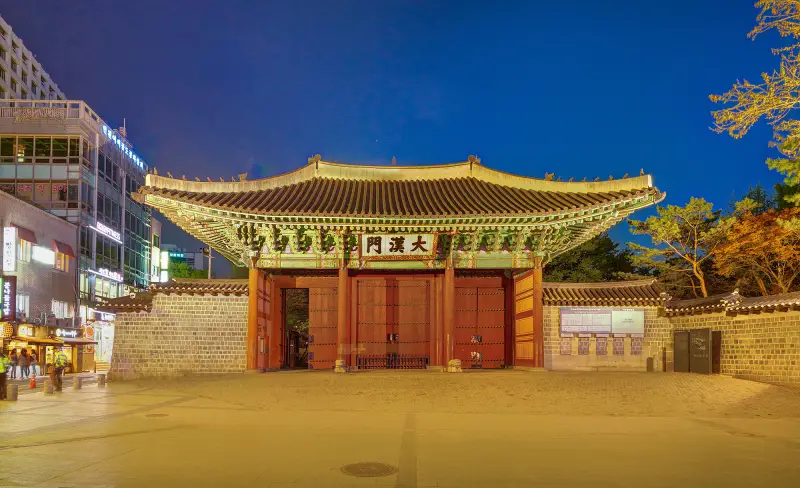
① Daehanmun
Daehanmun is the main gate of Deoksugung Palace. Originally, Inhwamun Gate in the south was the main gate of Gyeongungung Palace, but the area around Daeanmun Gate in the east became the new city center, including Hwangudan Altar, and thus took on the role of the main gate.
The current name was changed in 1906 (10th year of Gwangmu) during repairs. Originally, Daehanmun was located about 33m ahead, but it was moved to its current location when Taepyeong-ro was expanded in the 1970s.
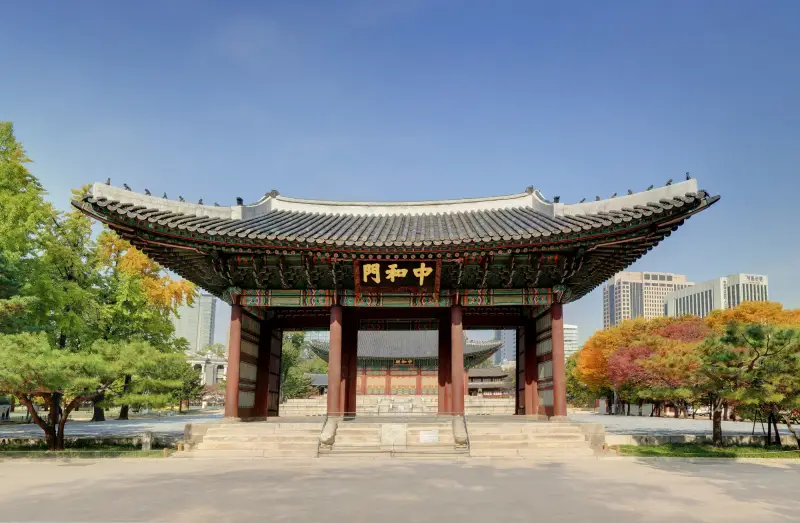
② Junghwamun
Junghwamun Gate is the main gate of Junghwajeon Hall, which was built in 1902. After being destroyed in the great fire of Deoksugung in 1904, it was rebuilt. Originally, there were corridors on both sides of Junghwamun, but currently only a part remains on the east side.
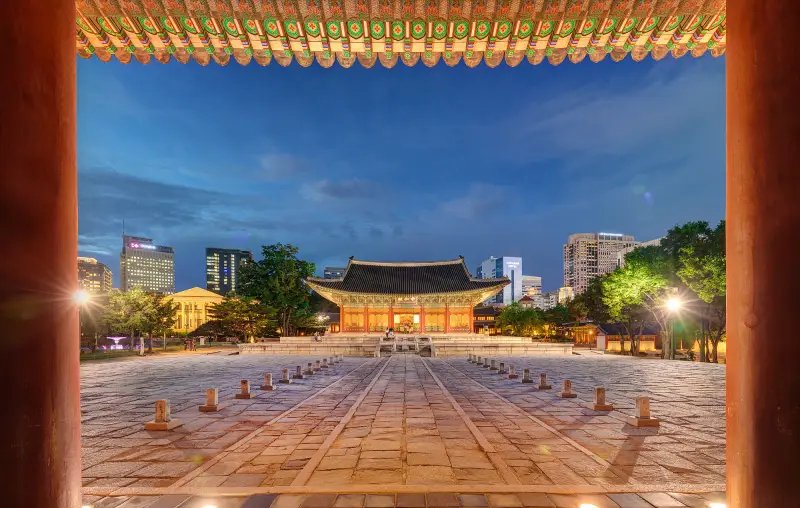
③ Junghwajeon
Junghwajeon Hall is the main hall of Deoksugung where important state events were held, such as court ceremonies and receptions for foreign envoys. The stairs leading to Junghwajeon are uniquely decorated with two dragons instead of phoenixes, unlike other main halls.
This is because the building was constructed after the proclamation of the Korean Empire, and dragons symbolize the emperor. In the courtyard of Junghwajeon, there are rank stones on both sides marking the positions where civil and military officials stood during ceremonies.

④ Junmyeongdang
Junmyeongdang Hall is connected to Jeukjodang Hall by a corridor. It was destroyed in the great fire of 1904 (8th year of Gwangmu) along with Jeukjodang and was restored the following year. In 1916, it was used as a kindergarten for Princess Deokhye, King Gojong’s daughter.
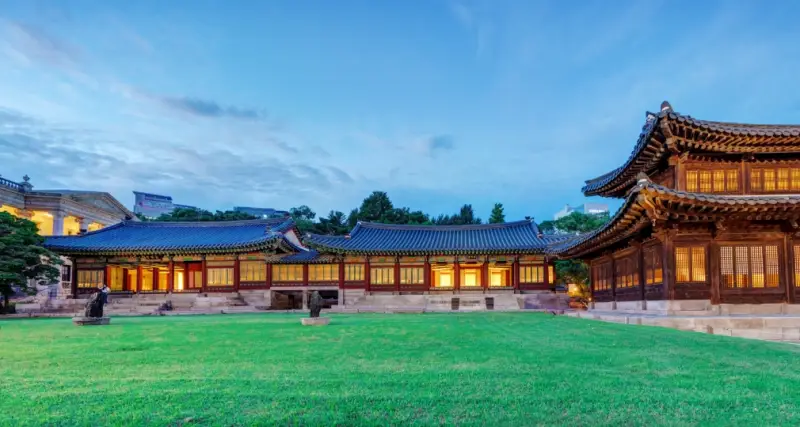
⑤ Jeukjodang
Jeukjodang Hall, along with Seokodang Hall, is one of the original buildings of Deoksugung. The name Jeukjo means royal accession. The 15th King Gwanghaegun and 16th King Injo ascended to the throne here, and after the establishment of the Korean Empire in 1897, it was used as the main hall.
It was then called Taegeukjeon and Junghwajeon, but when Junghwajeon was built in 1902 (6th year of Gwangmu), it reverted to being called Jeukjodang. Later, it became the residence of Royal Noble Consort Eom, King Gojong’s concubine, until her death in 1911.
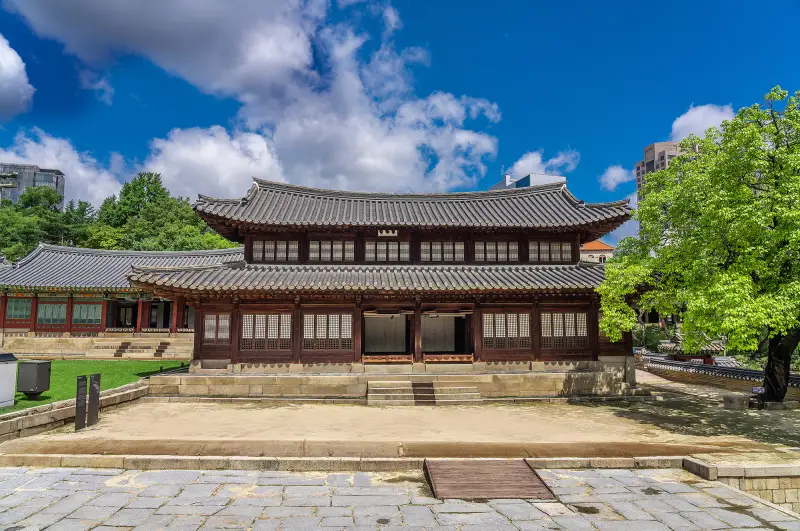
⑥ Seokodang
Seokodang Hall, along with Jeukjodang, is one of the original buildings of Deoksugung where King Seonjo temporarily resided during the Japanese invasion of Korea in 1592.
When King Injo returned most of the palace buildings to their original owners, he preserved Seokodang and Jeukjodang. Seokodang is the only two-story building remaining in Deoksugung and the only building without dancheong (traditional decorative coloring).
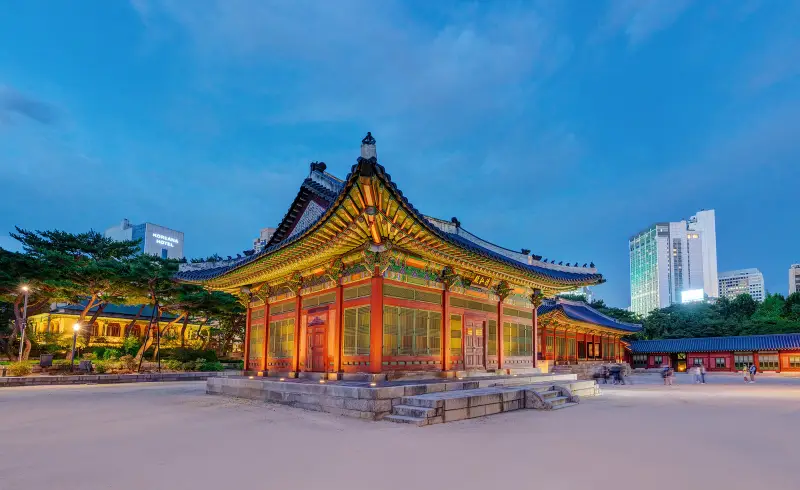
⑦ Deokhongjeon
Deokhongjeon Hall was originally the site of Gyeonghyojeon, which was the spirit hall of Empress Myeongseong, King Gojong’s queen. Later, King Gojong used it as a reception room for high-ranking officials and diplomatic envoys. The interior is lavishly decorated with chandeliers, phoenix-patterned dancheong, and plum blossom patterns.

⑧ Hamnyeongjeon
Hamnyeongjeon Hall, built in 1897 with King Gojong’s return to the palace, was the emperor’s bedroom chamber. After being destroyed by fire during ondol floor repairs in 1904 (8th year of Gwangmu), it was rebuilt the following year. King Gojong lived here until his death in 1919.
Behind Hamnyeongjeon, there is a terraced garden with beautifully decorated chimneys. Gwangmyeongmun, the main gate of Hamnyeongjeon, was relocated to its current position in 2018.

⑨ Jeonggwanheon
Jeonggwanheon Pavilion, according to the “Annals of King Gojong,” was temporarily used to house royal portraits of Joseon dynasty kings. Jeonggwanheon features both Western and Eastern architectural styles, with Romanesque-style artificial stone columns on a platform creating the interior space, and porches supported by columns on the east, south, and west sides. The railings are carved with traditional patterns including deer, pine trees, arabesque designs, and bats.
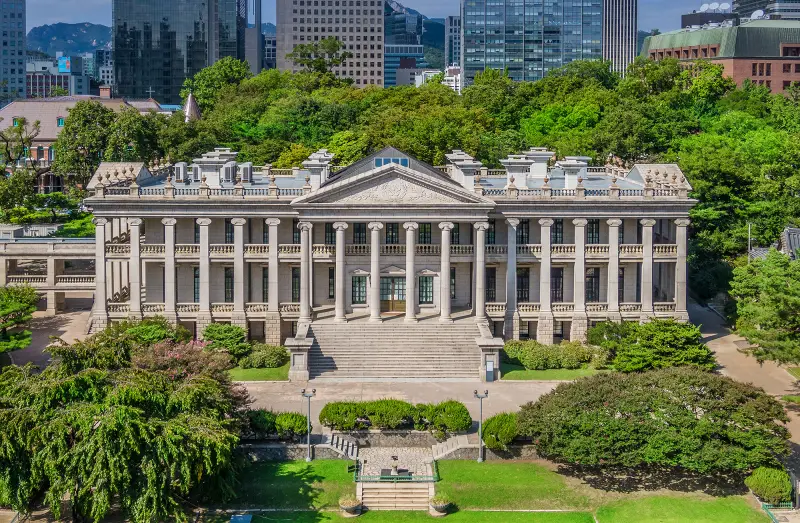
⑩ Seokjojeon
Seokjojeon Hall is a Western-style stone building built as King Gojong’s private quarters and audience hall. It was built in Western neoclassical style, featuring balconies on the front and both east and west sides. After its completion in 1910, King Gojong used it as a reception room for high-ranking officials and foreign envoys. It is currently open as the Korean Empire History Museum.

⑪ Western Seokjojeon
The Western Building of Seokjojeon (currently MMCA Deoksugung) began construction in August 1936 and was completed in June 1938, serving as the Yi Royal Family Art Museum. It is currently used as the National Museum of Modern and Contemporary Art, Deoksugung.
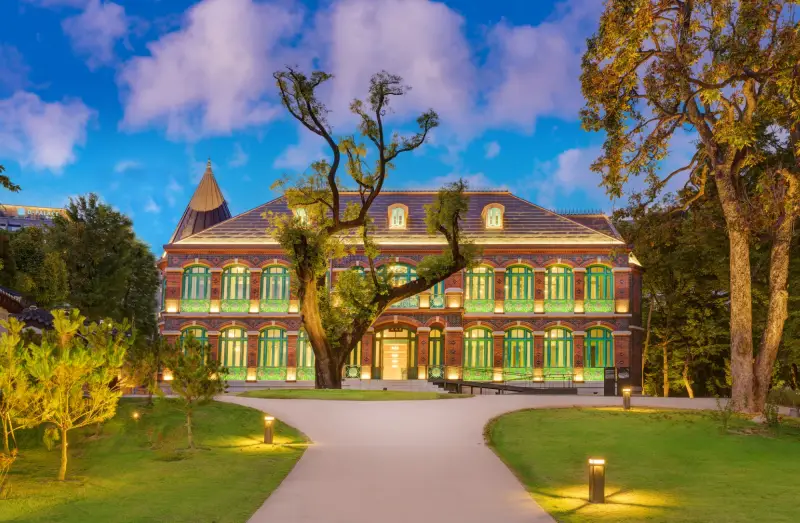
⑫ Dondeokjeon
Dondeokjeon Hall was built in 1902 (6th year of Gwangmu) for King Gojong’s 40th anniversary of accession celebration. Dondeok means “abundant virtue.” Built with bricks, it featured a splendid European-style exterior.
The first floor contained an audience chamber for meeting the emperor, while the second floor housed the emperor’s bedroom. It was used for diplomatic receptions, banquets, and as accommodation for state guests. Emperor Sunjong held his coronation ceremony here in 1907. After King Gojong’s death in 1919, it was abandoned and disappeared in the 1930s, but the Royal Palaces and Tombs Center reconstructed it in 2023.

⑬ Jungmyeongjeon
Jungmyeongjeon Hall was initially built in 1897 as the royal library and was called Suokheon. It appears to have been renamed Jungmyeongjeon after 1906. It is the unfortunate site where the Eulsa Treaty was signed in 1905 (9th year of Gwangmu). After the Japanese colonial period, it was used by civilians until restoration work in 2009, and opened as an exhibition hall in 2010.
2. Information
Visit Information :
Deoksugung Palace
- Operating Hours
- Admission Fee
- How to Get There
Deoksugung Operating Hours
| Week Day | Operating Hours |
|---|---|
| Tuesday-Sunday | 09:00 – 21:00 |
| Every Monday | Closed |
Deoksugung Admission Fee
| Visitor Types | Operating Hours |
|---|---|
| Adults (Ages 25-64) | 1,000 won |
| Youth (Under 24) | Free |
| Foreign Visitors (Ages 7-64) | 1,000 won |
How to Get to Deoksugung
Click ‘Here‘ to add it to Google Maps.
Exit 2 of City Hall Station (Line 1): 1-minute walk
Exit 12 of City Hall Station (Line 2): 1-minute walk
Get off at City Hall Bus Stop
Main Bus Lines: 172, 472, 504, 700, 701, etc.
Local Bus Lines: 1711, 7017, 7021, 7022, etc.
3. Highlight
Things to Do in
Deoksugung Palace
- Royal Guard Changing Ceremony
- Junghwajeon Hall
- Seokjojeon Hall
- Jeonggwanheon Pavilion
- Hamnyeongjeon Hall
- Junmyeongdang
- Evening Tours of Deoksugung
- the National Museum of Modern
- Seokjodang
Watch the Majestic Royal Guard Changing Ceremony at Daehanmun Gate
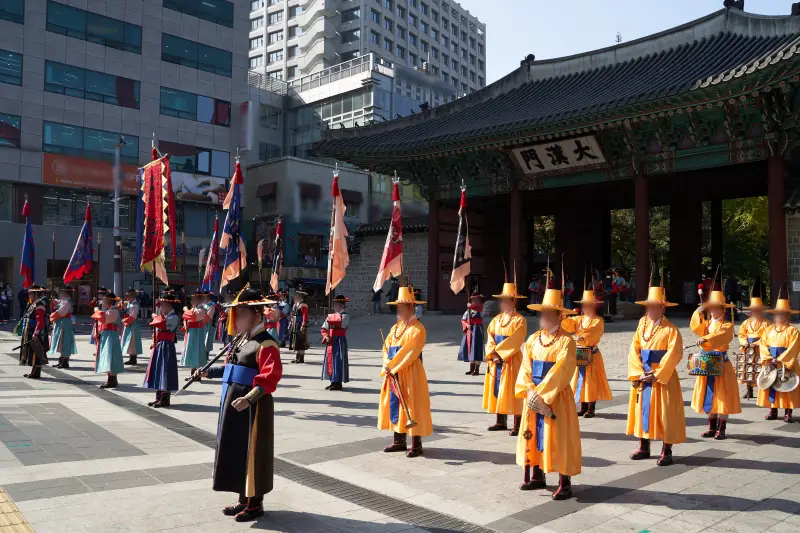
The Royal Guard Changing Ceremony takes place three times a day in front of Daehanmun, the main gate of Deoksugung Palace.
This ceremony, which recreates the tradition of the royal guards who protected the palace during the Joseon Dynasty, is performed at 11:00 AM, 2:00 PM, and 3:30 PM, lasting approximately 20 minutes. The guards, dressed in magnificent traditional uniforms, present a spectacular sight accompanied by the solemn performance of traditional musical instruments.
The traditional weapons and ceremonial items carried by the guards, such as spears, swords, bows, and ceremonial flags, offer insights into the palace’s security system of that era. After the ceremony, visitors have the opportunity to take commemorative photos with the royal guards, creating unforgettable memories.
Experience the Majesty of Joseon at Junghwajeon Hall

Junghwajeon Hall, the main throne hall of Deoksugung Palace, perfectly embodies the dignity and formality of the Korean Empire period. This space, where imperial coronations and major ceremonies were held, is a prime example of traditional wooden architecture’s beauty.

The ceiling decorated with dragon and phoenix patterns and the intricate dancheong (traditional decorative coloring) are particularly breathtaking.
The elevated platform of Junghwajeon, situated atop a flight of stairs, symbolizes imperial authority, while the spacious front courtyard adds to the solemnity of ceremonial occasions. Inside Junghwajeon, visitors can find a recreation of the emperor’s dragon throne, offering a vivid glimpse into the court culture of the Korean Empire.
Admire Western Architecture at Seokjojeon Hall

Built in the early 1900s, Seokjojeon Hall is Korea’s first Western-style stone palace building. Incorporating Victorian architecture from Britain, this building captures the splendor and elegance of Renaissance style. Currently housing the ‘Museum of the Korean Empire,’ it displays historical artifacts and photographs from the Korean Empire period.
Interior tours of Seokjojeon Hall are only available through guided tours with advanced reservations. While Korean visitors must make online reservations through a personal verification process, foreign visitors can make same-day reservations on-site, limited to the first 5 people.
Therefore, foreign tourists who wish to tour the inside of Seokjojeon Hall should visit the site directly to make a reservation.
The emperor’s office and reception rooms on the second floor are particularly valuable spaces for glimpsing the Western-style court culture of the time. The grand staircase, chandeliers, and fireplaces provide visitors with a vivid representation of how Joseon was embracing Western culture in the late 19th century.
Discover Modern Cultural Heritage at Jeonggwanheon Pavilion

Jeonggwanheon is a Western-style pavilion built during the Korean Empire period, where Emperor Gojong received foreign envoys and enjoyed tea. This two-story wooden building showcases an exquisite blend of Western and Korean architectural styles. The first floor served as a Western-style reception room, while the second floor was decorated as a traditional tea room.
It’s said that this is where Emperor Gojong first tasted coffee, making it a significant site in Korea’s modern cultural history. Jeonggwanheon is also famous for offering particularly beautiful views of Deoksugung Palace.
Glimpse into Emperor Gojong’s Daily Life at Hamnyeongjeon Hall

Hamnyeongjeon Hall, where Emperor Gojong actually resided, offers insights into the king’s daily living space. This building, consisting of an anchae (main building) and haengnangchae (servants’ quarters), exemplifies traditional hanok architecture and provides important clues for understanding royal lifestyle and culture.
Inside Hamnyeongjeon, visitors can see recreations of Gojong’s bedroom and study, offering a vivid glimpse into royal life during that period.

Reflect on Emperor Gojong’s Final Days at Junmyeongdang

Junmyeongdang holds profound historical significance as Emperor Gojong’s final residence and the place where he passed away. The building showcases a unique blend of Western and Korean architectural styles, featuring particularly impressive window designs and grid-patterned wallpaper.
Emperor Gojong passed away here on January 21, 1919, just before the March 1st Independence Movement began. Junmyeongdang stands as a historical site marking the final moments of the Korean Empire.
Create Special Memories with Evening Tours of Deoksugung

After sunset, Deoksugung Palace reveals a completely different charm. The palace buildings and walkways take on a romantic atmosphere under soft lighting, creating a serene ambiance unique to nighttime.

The evening view of Seokjojeon Hall is particularly spectacular, reminiscent of European castles at night. Since evening viewing hours vary by season, it’s recommended to check the schedule before your visit.

Visit the National Museum of Modern and Contemporary Art
The National Museum of Modern and Contemporary Art, located within Deoksugung Palace, is a unique cultural space where tradition meets modernity. Housed in a renovated historic building, the museum features various contemporary art exhibitions. The combination of the palace’s traditional atmosphere with sophisticated modern art creates a distinctive cultural experience you won’t find anywhere else.
Experience Traditional Beauty at Seokjodang

Seokjodang, one of the oldest buildings in Deoksugung Palace, perfectly preserves the beauty of traditional Joseon architecture.
Its elegant eaves and intricate window patterns particularly showcase the aesthetics of Korean traditional architecture. Originally used as the Crown Princess’s quarters, it now houses exhibitions displaying artifacts that offer glimpses into royal court life.
Insider Tips for
Deoksugung Palace Like a Local
- Join a Guided Palace Tour
- Hanbok Rental
- Royal Culture Festival
Join a Guided Palace Tour
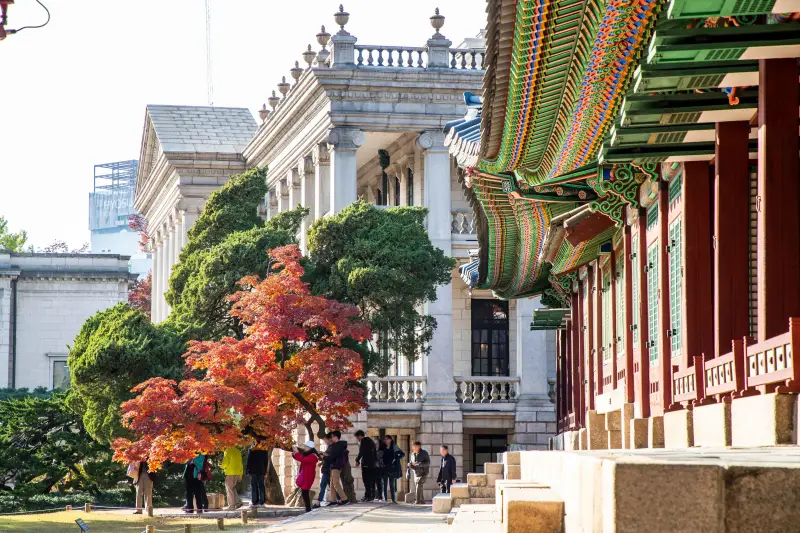
To gain a deeper understanding of Deoksugung Palace, take advantage of the free guided tours operated by the Cultural Heritage Administration. These expert-guided tours are available daily except Mondays and require no advance reservation.
Foreign Language Tour Schedule:
English: 10:45, 13:30
Chinese: 10:00, 14:30
Japanese: 09:30, 16:00
※ Tours may be canceled, shortened, or adjusted depending on museum circumstances. Please check the official website for the most up-to-date information.
The guides provide detailed explanations about hidden stories of each building, architectural features, and historical events that would be difficult to discover on your own. Their professional insights about features like Seokjojeon’s Western architecture and Junmyeongdang’s historical significance add much more depth to your palace visit. Tours last approximately one hour and begin at the information desk in front of Daehanmun Gate – just arrive a few minutes before the scheduled time.
Create Special Memories with Hanbok Rental

Various hanbok (traditional Korean clothing) rental shops around Deoksugung Palace can make your palace visit even more special. Wearing hanbok not only gives you free admission to the palace but also provides perfect photo opportunities against the palace’s scenic backdrop.
The spacious courtyard in front of Junghwajeon Hall and the lawn in front of Seokjojeon Hall are particularly popular spots for hanbok photography.
Rental options typically range from 4-hour to full-day courses, and you can also rent accessories like traditional hair ornaments and bags. However, since rental shops tend to be very busy on weekends, advance reservations are recommended.

Participate in the Royal Culture Festival
The Royal Culture Festival, held every spring and fall, offers the most spectacular way to experience Deoksugung Palace. During this period, the Royal Guard Changing Ceremony becomes even more magnificent, and special performances recreating royal ceremonies from the Korean Empire period are presented.
Visitors can try on royal imperial costumes, participate in traditional craft workshops, and watch royal cuisine demonstrations among various interactive programs. The evening programs are particularly special, featuring media facade shows and nighttime performances that make the palace’s night view even more spectacular. Specific festival dates and schedules can be found on the Cultural Heritage Administration’s website.
Is Deoksugung Palace
Worth Visiting?
An Invitation to a Place Where Time Stands Still
The answer is a resounding “yes.” Deoksugung Palace holds unique value that cannot be found in any other palace. As the last palace of Joseon and the birthplace of the Korean Empire, it serves as a living museum that perfectly encapsulates Korea’s transitional period.
Deoksugung’s greatest charm lies in the coexistence of tradition and modernity. It’s the only place where you can find Junghwajeon Hall, showcasing the essence of traditional Korean architecture, alongside Seokjojeon Hall, reminiscent of European palaces, in the same space. This architectural contrast seems to physically represent the dramatic changes Joseon underwent in the late 19th century.
Moreover, Deoksugung serves as a valuable cultural retreat in the heart of the city. Amidst modern skyscrapers, it preserves the quiet beauty of tradition, offering a peaceful sanctuary for today’s busy urbanites. The stone wall path around Deoksugung, beautiful in all four seasons, is beloved as one of Seoul’s premier dating spots and walking courses.
From a value perspective, Deoksugung is an excellent choice. For just 1,000 won ($0.75), visitors can appreciate buildings with hundreds of years of history and enjoy traditional cultural events like the Royal Guard Changing Ceremony for free. With the addition of the National Museum of Modern and Contemporary Art within the palace grounds, what could be a better cultural experience?
For international visitors to Seoul, Deoksugung is the perfect place to witness Korea’s traditional culture and modernization process at a glance. In one space, you can experience both traditional hanok and Western-style architecture, and observe the meeting of Eastern and Western cultures, from Emperor Gojong’s coffee culture to Western-style royal banquets.
Deoksugung is not just another ancient palace – it’s a special space where history, culture, and the present coexist. Here, you can become a time traveler, simultaneously experiencing the last breath of Joseon and the first steps of the Korean Empire. At this very moment, Deoksugung awaits your visit.
Frequently Asked Questions
4. Review
What Travelers Are Saying
5. Near by
Top Spots to Explore
near Deoksugung Palace
- Seoul Museum of Art
- Deoksugung Stone Wall Path
- Seoul City Hall Plaza
Seoul Museum of Art

Just a three-minute walk along Deoksugung’s stone wall path brings you to the Seoul Museum of Art, another cultural landmark of Seoul. Built in 1928, this building formerly served as the Supreme Court building and features an impressive Renaissance-style exterior.
Currently operating as a modern art museum, it hosts year-round special exhibitions and permanent collections by renowned Korean and international artists. The building shares architectural similarities with Deoksugung’s Seokjojeon Hall, adding to its historical value.
Admission is generally free, though some special exhibitions may require a fee. You can easily find it by turning left at Deoksugung’s main gate and following the stone wall path.
Take a Stroll Along Deoksugung Stone Wall Path

The stone wall path of Deoksugung is considered one of Seoul’s most beautiful walking trails. Following Jeongdong-gil, these walls were built during the late Joseon period and perfectly preserve the beauty of traditional hanok walls.
The path becomes especially romantic in spring when cherry blossoms bloom and in autumn when ginkgo trees turn golden, creating a stunning harmony with the stone walls.
Along the Deoksugung stone wall path, you’ll encounter various modern historical buildings such as Jeongdong Church, Jungmyeongjeon Hall, and the former Russian Legation, adding historical significance to this route.

The path becomes especially romantic in spring with cherry blossoms and in autumn with golden ginkgo leaves decorating the stone walls. Various cafés line the 900-meter stretch from Daehanmun Gate to Jeongdong Theater, perfect for enjoying a relaxing tea time after touring the palace.
The café street along Deoksugung’s stone wall path is one of Seoul’s most beloved dating spots. The unique atmosphere created by the contrast between the ancient stone walls and modern cafés creates a special charm.

Most cafés along Jeongdong-gil are in buildings of two or more stories, with window seats offering serene views of the historic stone wall path.
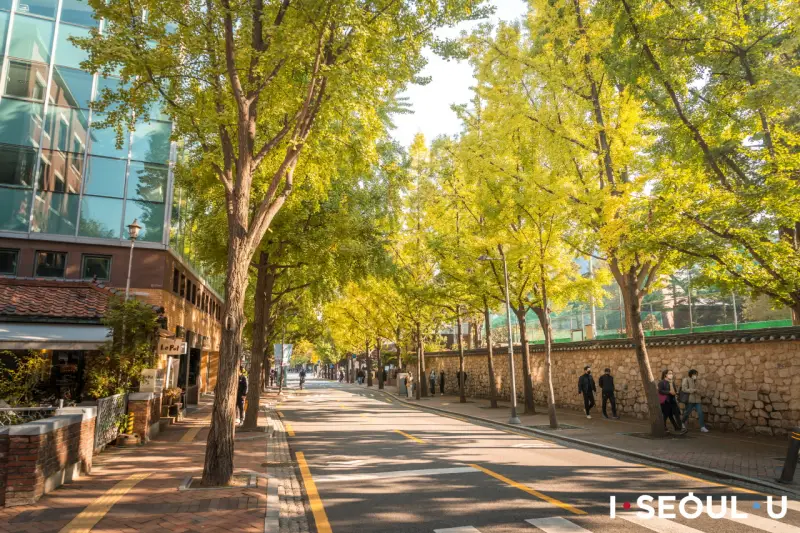
Seoul City Hall Plaza
Located opposite Deoksugung’s Daehanmun Gate, Seoul City Hall Plaza serves as an open cultural space in the heart of the city. With its green lawn and fountains, this area functions as both a citizen’s rest area and a multipurpose cultural venue.
The plaza offers seasonal attractions: an outdoor film festival in summer and an ice skating rink in winter. The juxtaposition of the new and old City Hall buildings provides a visual representation of Seoul’s past and present. It’s easily accessible from Deoksugung – just cross the crosswalk in front of the palace.

